A Butterfly Flies In From Paris - Par Avion
Wednesday, December 31, 2008
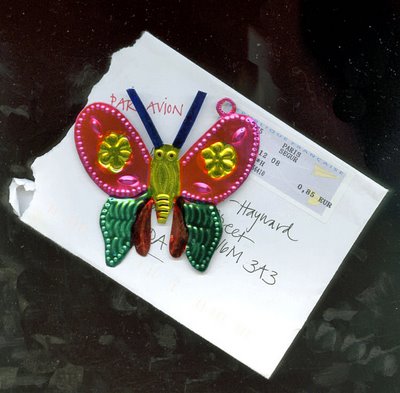
I phoned Rebecca and said,"¿A qué no sabés lo que llegó hoy?" (Guess what arrived today.) Her answer was quick, "Llegó el regalito de Homero." (Homero's little gift arrived.)
That yearly and pleasant routine while not exactly on schedule this time (the snow?) was delivered yesterday. Homero Aridjis, the butterfly man, the man who loves butterflies, came through with his little present, all the way from Paris. In the envelope there was a Mexican tin Christmas ornament. It was a most unusual one as this is the first butterfly Aridjis has ever sent me. It has to be special. How many get a butterfly to fly all the way from from Paris (Par Avion) on December 30 when the snow outside is not melting?
The little ornament, which will hang with all the other tin ornaments from a string of red yarn on the front living room window by the Christmas tree, made me want to look into one of my favourite books by Aridjis, ¿En Quién Piensas Cuando Haces El Amor? (In whom do you think when you make love?) Alfaguara, 1995. This novel is about a Mexico City in a scary future based on a very scary present when pollution is killing the great cypresses of Chapultepec Park and birds plummet from the sky like stones. The narrator of the novel, Sanchez is present when María, twin sister to Rosalba finds out that Rosalba has died. Rosalba and Sanchez go to the burial.
Perdí noción de la hora, había dejado mi reloj de pulsera en el bolso y el bolso en la recámara de Rosalba. Una mariposa se posó en mi frente. La cogí con la mano.
Delante de nosotros pasaron docenas de mariposas monarcas. No las veía desde mi infancia. Desorientadas anduvieron entre las tumbas y los árboles muertos, quizás en busca de agua. Una de ellas, como sobreviviente de la extinción biológica y como fantasma de migraciones pasadas, fuera de lugar y de tiempo, se posó en el pelo de María.
I lost all notion of time, I had left my wrist watch in my bag and the bag in Rosalba's bedroom. A butterfly alighted on my brow. I caught her with my hand.
Dozens of monarchs flew by. I had not seen them since my youth. Lost they flutterd among the tombstones and the dead trees. Perhaps they were looking for water. One of them, like a survivor of a biological extinction and like a ghost of past migrations, out of place and time, rested on María's hair.
I have read this beautiful passage so many times but only today did I bother to look up the origin of the Spanish mariposa. Hidden in the word is "pose for me Mary". The verb posar in Spanish has the double meaning to pose and to rest.
The arrival of the little tin butterfly made me think that somehow, while a little bit early for her spring migration, she is a monarch that knows where home is.
Goh For Gold (Cultural) In 2010 Olympics
Tuesday, December 30, 2008
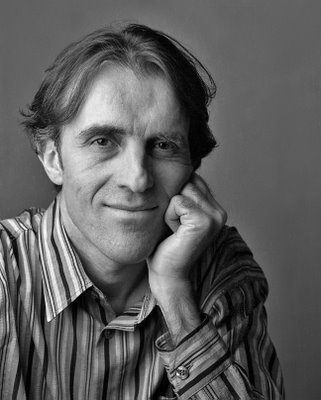
An open blog to VANOC's Cultural Olympiad Czar Robert Kerr (left)
In November 2007 I read with interest and some degree of optimistic pleasure this article in my Vancouver Sun. Since then I have begun to feel some anxiety and have felt a tad depressed about it. It was only last week that while talking to someone (an important player in our city's cultural affairs) about who was going to appear in our 2010 Cultural Olympics that I realized I had a good reason to feel that anxiety and depression. This is what she said, "When VANOC announced its plan in 2007 and how cultural organizations could apply for participation many of us saw too many barriers and much bureaucracy. So we just didn't bother to apply." I am not quite sure she is right or that VANOC is as terrible a monolithic organization as some think. I know for a fact that they have been instrumental in helping fund the Pacific Baroque Orchestra's program to bring music to the Vancouver East Side with its free concerts at St James Anglican.
There is a funny word in Spanish, much funier than its English equivalent laughingstock. It is hazmerreír or literally "make me laugh". I am beginning to believe that our cultural Olympics might just make us the hazmerreír of the world.
Consider the following which are not in any special order and probably heavy into dancing since I am heavy into dancing. I saw them all and probably many more that with the fading memory of my age I have ovelooked but many who might read this will point them out. Will any be part of the cultural Olympics?
Trout Stanley by Claudia Dey
Trout Stanley is a play about the Canadian (BC) North produced by our local Ruby Slippers. This play won many awards in spite of being most entertaining and funny. To top it all it had a cast that featured some of our best actors including Jonathon Young and Lois Anderson.
Studies in Motion: The Hauntings of Eadweard Muybridge
by Kevin Kerr, Electric Theatre Company
No Exit by Jean-Paul Sartre, Electric Theatre Company
Both plays directed by Kim Collier would make Vancouver proud. Studies in Motion incorporated choreographer Crystal Pite. I can make the blanket statement that anything by or with Crystal Pite is worth watching.
His Greatness by Daniel MacIvor - Arts Club Theatre Company
His Greatness a play about Tennessee William's days in Vancouver shortly before he died combines stuff that would appeal to an international jet set audienced yet show a bit about our city. This play was produced by the Arts Club.
The Matka King and Bombay Black both by the Arts Club Theatre Company
Both these plays performed by the Arts Club Theatre Company are very Indian yet in many ways very Canadian by an Indian playwright and novelist of note Anosh Irani.
The Magic Flute by Mozart - Vancouver Opera
This Vancouver Opera production with dazzling sets and a setting production centered in the world of the North West coast aboriginal community is an opera that would be acclaimed for its originality anywhere in the world. There are many young Native Canadian singers who can sing the parts including Melody Mercredi.
Naomi's Road- Vancouver Opera
This accessible opera based on Joy Kogawa's internment in a camp in BC during World War II and with music by young local composer Ramona Luengen is an opera that my 9-year old granddaughter loved but also managed to entertain me. I wonder how much of VANOC's cultural olympics will appeal to children?
Game Misconduct - Presented by Festival Vancouver
in association with the
Vancouver Playhouse Theatre Company
This contemporary hockey opera with music by Leslie Uyeda and librettist Tom Cone with music performed by Standing Wave was a terrific comedy on how Canadians view hockey as an essential part of their lives. The re-mounting of this opera would also show off the musical brilliance of Standing Wave.
The Goldberg by John Alleyne
This 1998 look at Bach's Goldberg Variations as interpreted by a modern ballet company, Ballet BC was a revelation. It's use of recorded music could be improved (see below) to make this John Alleyne ballet a masterpiece.
The Goldberg Variations by a string trio.
Some years ago I attended a concert in which a string trio playing period baroque intstrments played an orchestration of Bach's Goldberg Variations. It was an evening of fun and wonder. The trio was composed of members of the Pacific Baroque Orchestra, violinist Paul Luchkow, violist Angela Malmberg and cellist Laura Kramer. I would love to watch Alleyne's The Goldberg with live music by this trio.
The Faerie Queen John Alleyne and Ballet BC
This is another terrific John Alleyne piece for modern ballet that explores Purcell's music as adapted by two of Vancouver's most noted new music composers Michael Bushnell and Owen Underhill.
EDAM with Peter Bingham
Peter Bingham's brand of contact improvisational dance is cutting edge dance that is still accessible and fun. A collaboration by Bingham and Crystal Pite, Vanishing Point is memorable for me as one of the most dazzling displays of theatre/dance I have ever seen.
Brief Encounters & Dances for the Small Stage
Both of these separate dance organizations Brief Encounters and Day Helesic's Dances for a Small Stage offer small stand alone dance performances that mix various media and can be performed in minium space to alll audiences. Many Vancouver choreographers of note have been involved with Dances for a Small Stage.
Anything by Choreographer Jennifer Mascall
But especially a production of her dance The Brutal Telling based on the life of BC artist Emily Carr.
Anything by Karen Jamieson Dance.
More than anybody Karen Jamieson has worked hard to fuse modern dance forms with elements of Canadian aboriginal dance and aboriginal culture.
Blood Alley by Byron Chief-Moon
I have seen Byron Chief-Moon dance with the Karen Jamieson Dance Company but this solo performance of his is dramatic and thrilling.
Fan Dance by the Goh Ballet
Just a few months ago I saw a fan dance at the Goh Ballet that incorporated both Asian and non Asian dancers. It was terrific to hear those large fans open and close. I cannot think of anything more appropriate to show off our multiculturalism.
Anything involving dancer/choreographers Shay Kuebler, Amber Barton Funk and Josh Martin.
These three dancer/choregraphers have fused modern dance to hip-hop and produced an amalgamation that works and is exciting, too.
Slab by choreographer Chick Snipper
This startling dance based on 16th century anatomist Andreas Vesalius incorporated new music with musicians like the internationally renowned local cellist Peggy Lee.
Anything by Bard On The Beach
There is nothing like Christopher Gaze's Bard On the Beach anywhere else in the world that has the setting of Vancouver as a back stage.
The Borealis Quartet
I saw a performance of this quartet of young virtuosi at the Dr. Sun Yat-Sen Chinese Classical Garden last year. A superb group in a superb setting.
Anything by the Vancouver Symphony and Bramwell Tovey. Anybody who can pass muster with the critical audience of New York City would surely delight the world that is coming to us during the 2010 Olympics.
Blod Mixes Inside My Heart by Kevin Loring -Vancouver Playhouse
This play set in Lytton BC was a wonder to watch and listen to. Kevin Loring's play is a must.
Three Sixty Five by Wen Wai Wang
This modern dance piece by Wen Wai Wang and his company featuring a musically deconstructed score of Vivaldi's Four Seasons and performed with cellist Peggy Lee was Vancouver dance at its most avant-garde.
Anything by Kidd Pivot's Crystal Pite
Vancouver Jazz. I could think of many but these young performers come to mind besides our city's one and only Brad Turner. There is Amanda Tosoff and Cris Derksen.
The Pacific Baroque Orchestra
Some years ago the PBO under the helm of virtuoso violinist Marc Destrubé organized a spectacular concert at the UBC First Nations Longhouse that featured baroque (proto ballet) dancers in juxtaposition to contemporary (17 century) First Nations dance.
Mr. Kerr is it too late to incorporate any of these acts?
Magic, A Red Schuco, Alfonso Cuarón & Mervyn Fernandez
Monday, December 29, 2008

From when I can remember I can recall asking my father, "Tell me a story." And in Spanish my cousin Wency and I would ask his father, "Contanos un cuento de piratas, de espadachines o de conbois." (Tell us a story about pirates, deft swordfighters or cowboys.)
Today's blog begins at the dinner table. Lauren started with, "Papi how do you say chicken in French?" For a long time I have been giving her "le shiken" with my best French accent. Lauren has given up telling me that the correct word is poule and simply says with a fair degree of accuracy, "You don't know how to speak French." This time Rebecca did not stay out of the conversation and agreed with Lauren that poule was the right term for chicken.
I immediately got up from the table to fetch from my living room library my copy of Through the Looking-Glass - And What Alice Found There, and read to them:
'When I use a word,' Humpty Dumpty said, in rather a scornful tone, "it means just what I choose it to mean - neither more nor less.'
'The question is,’ said Alice, 'whether you can make words mean so many different things.'
'The question is,’ said Humpty Dumpty, ‘which is to be master - that's all.'
Rebecca then asked me, "So is le shiken correct?" I attempted to fudge but I finally said, "For me it is," and added, "the important thing to learn is that we must take control of the words in our vocabulary and not let them rule us." I could have added but she would not have understood, "A synonym is a word you use when you don't know how to spell the other one."
What all the above has to do with story telling is that this afternoon we sat down to view a DVD of a film I carefully chose last night. It is Mexican Alfonso Cuarón's version of the often filmed story A Little Princess by Frances Hodgson Burnett. This 1995 film has minor special effects only in some wonderful dream sequences. The rest of it hinges on acting, and the idea that magic happens if you believe in it. It is a magic of the imagination and both of our little granddaughters, Rosemary and I had to imagine that a bare and ugly attic became a little Hindu palace overnight because of an intriguing Indian manservant with a monkey on his shoulder. While we had enjoyed the previous evening's viewing of Pixar's WALL-E, here was a film in which just the story was sufficient to please two cynical adults and two soon-to-be cynical children. The little girl in A Little Princess has a penchant for telling stories. And from her father she has learned that magic exists if you believe in it.
I was 8 and Santa Claus had brought me a red Schuco racer (about 15cm long) with steering, suspension and a gear shift that worked! I was driven by a windup mechanism which needed a large key. Within the hour I had lost the key and loudly cried to my father that all was lost and that I wanted to die. With a smile on his face he told me, "Alexander, Santa Claus knew this was going to happen so he entrusted me with an extra key. Here it is." To me this was pure magic and I have never forgoten it. I absolutely despise little boys (they are never little girs) who try and figure out a magician's tricks during a performance. And when they think they know, they loudly proclaim the fact to those who still believe in magic.

Mervyn "Swervin Mervyn" Fernandez was a fantastically slippery wide receiver for the BC Lions around 1985 when I photographed him. For the picture I wanted to show how Fernandez seemed to have some sort of magical magnetism in his hands that could attract and catch a football even if the pass was a bad one. For the shot I used a black coat hanger wire which was attached as a belt around Fernandez's waist and clamped on to the ball with expoxy glue. To me my trick was simple yet now, in 2008, the trick would be a lot simpler and perhaps because of it less believable since I would use Photoshop.
After seeing Cuarón's beautiful A Little Princess I understand more than ever that a child's imagination is something that has to be nurtured and preserved. The power of story telling seems to be waning as th special-effects-reality of films and games is seen as better, more colourful and more exciting. Who knows while Rebecca might think she is too old for this kind of thing there is still a chance that Lauren, just might soon ask me to tell her a story. The problem is, if not cowboys, pirates and deft swordfighters, then what?
An iPod, A Shuffle Setting & Memory Of A Christmas Past
Sunday, December 28, 2008

Last night as I was telling Rosemary of my efforts to locate my fellow classmates from St Edward's High School in Austin( 1957-1961) because of a first ever reunion in June she told me, "Alex you are living in the past."
There have been other reunions at St Ed's that have incorporated the high school (1925-1972) with St Edward's University which, unlike our Texas Landmark of a school, is still going strong. The significance of the June reunion is that it is only for the high school. My search for fellow classmates has taken me to an adobe brick factory in Alcade, New Mexico and to the story of a young 22-year-old man who was a car jockey at the LAX Airport. He had to park Tony Curtis's Maserati. While driving it he saw a fruitless future. He saw the light and quit his job. He went into law school and now teaches law in San Antonio. My search took me to the lore and history of the King Ranch (the largest ranch in the US) as I tried to figure out exactly who Michael East was in this scheme of things. This story involves a heiress who is befriended by a priest who convinces her to change her will so that the money would go to his order as opposed to the Diocese of Chorpus Christi and her heirs. A big lawsuit ensued and the presiding judge was the man whose son saw the light while driving the Maserati. Of Michael East I remember a young man with strange eyes (was one green and the other blue?) who wore jeans with spurs, a cowboy hat the first time I ever saw him. He was quiet-spoken, gentle and kept to himself. Why had he come to St Ed's?

When Rosemary told me of my living in my past I was left speechless (for a moment). This interest of mine in my relationship with classmates from a boarding school whom I have not seen since 1961 has kept me occupied these last few days. I am about to finish Umberto Eco's novel The Mysterious Flame of Queen Loana which I am sure is partly an autobiography of Eco and particularly of his childhood under Mussolini.
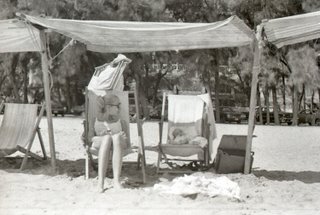
The explanation of the novel on the back cover is as follows:
Yambo, a sixtyish rare-book dealer in Milan has suffered a loss of memory - he can remember the plot of every book he has ever read, every line of poetry, but he no longer knows his own name, doesn't recognize his wife or his daughters, and remember nothing about his parents or his childhood. In an effort to retrieve his past, he searches through boxes of old newspapers, comics, records, photo albums, and adolescent diaries. And so Yambo relives the story of his generation: Mussolini, Catholic education and guilt, Josephine Baker, Flash Gordon, Fred Astaire. His memories run wild, and life races before him in a series of images, as Yambo stuggles to capture one- that of his first love.

My retort to Rosemary's troubling comment was one where I related my reading of Lawerence Durrell's Alexandria Quartet (Justine, Balthazar, Mountolive, Clea) and how these novels present four perspectives on a single set of events and characters in Alexandria, Egypt, before and during World War II. The Quartet are an exploration of relativity and the notions of continuum and subject-object relation, with modern love as the subject. The Quartet offers the same sequence of events to us through several points of view, allowing individual perspectives to change over time. I explained to Rosemary that examining the lives of all these boys now is like looking at my own life from a different point of view. I have written here of Julian Barnes's book nothing to be frightened of. In it he relates of his journeyd from atheism to agnosticism. In grade 11 my fellow classmate John M. Straney (now dead) began to loudly proclaim (in our Catholic boarding school) that he no longer believed in the existence of God. I remember arguing with him to no avail. I remember bringing him to the presence of Brother Edwin Reggio CSC who taught us religion and saying to Brother Edwin, "John says he no longer believes in God." Somehow Brother Edwin never took him to task and played a duck in the rain. I am sure other schools would have summoned the boy's parents and then expelled him. Nothing like this happened.

I am now able, especially in these wonderfully lazy days between Christmas and the Epiphany (January 6) to contemplate all these events of my past and reconcile them to my present. From there I can resolve how those past events will form or decide my future.
The photos in today's blog are from my past. But they are strange in some ways that remind me the shuffle tab of my Sony CD player. This shuffle device ushered in the random playing possibilities of my Rebecca's new Christmas iPod. The iPod and the demise of long playing albums and the eventual dissapearance of the CD are all about to destroy the order of first page first and last page last that Gutenberg's press brought to us in 1439.
The photos in today's blog are the product or a personal custom of my era in the 60s when I would keep a 36-exposure roll in my camera for months. I would then process it months later and cut the strips into frames of 6, not taking into consideration subject matter or seasons of the year. In two pages of negatives I have here a selection of our first 1968 Christmas in Veracruz with our four-month old daughter Alexandra Elizabeth and a last picture featuring the four of us with the newborn Hilary near our house in Arboledas in 1972. In between there are pictures of my mother with Ale and of my Aunt Dolly with Ale and even one of my mother's dog, a boxer called Antonio with the owner's son. Christmas in Veracruz were obviously hot as there is a picture here of Rosemary on Mocambo beach sitting with a tiny Ale under an awning.

When Ale was born in August of 1968 we traveled to Veracruz a few weeks later in our VW bug to show of the kid to my mother. On the way I slipped off a curve (I was driving too fast) and turned over. We were saved by new-fangled seat belts that had come with the purchase of two new Firestone tires. Ale was saved because she was in a hooded wicker basket in the back seat. The hood saved her. Some farmers turned the car right side up and I slowly drove the lopsided vehicle to a worried mother who was anxiously waiting for us.
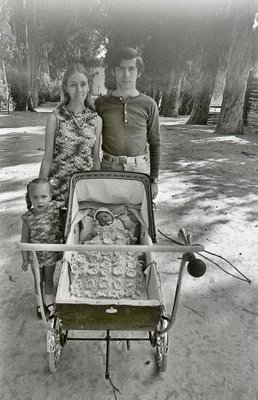
A few weeks later she visited us in Mexico City and told us we needed an English pram. She picked up the daily News a Mexico City paper in English) found a used pram. We went to see it and promptly bought it. We were delighted with the elegant dark blue lacquer finish on the wood body.
My old negative book has no obvious order. It is a 1968-1972 shuffle that in an unsettling way (I feel that unsettling now) predicted an era when one will no longer be able to say, "If you think this cut is nice wait until you hear the next one." How will that iPod affect Rebecca's memories in a near future? I look back and I can remember with a luxury of detail Dan Sherrod's album The Gibraltar Grand Prix in which Peter Ustinov was the voice of all the drivers (the German, the Frenchman, the Italian, the Aregentine and also all the special effects noises of the cars). I remember it all in the "correct" order.
I feel no different from Umberto Eco's Yambo who is looking into old boxes to make some sense from his past from a forgotten present.
The Spooks Were Cool
Saturday, December 27, 2008

I have written twice here and here about my wonderful relationship with libraries and in particular with the 1960s la Biblioteca Benjamín Franklin in Mexico City. It was a USIS (United States Information Service) facility which was the public face of the CIA. The Benjamin Franklin was located in that most fashionable area called La Zona Rosa or Pink Zone. They had a wonderful selection of books in English and a magazine and periodical section to die for. It was here that I could read both Downbeat and Scientific American sitting comfortably on a lounge chair and not standing uncomfortably by the magazine rack of the nearby Sanborn's. In 1962 I tried to take some books home but the female attendant at the front desk told me I needed a library card. One of the requirements was a passport type photo. So I went home and put my camera (a Pentacon-F) on a tripod and accessed the self-timer. I made a print to the size specification of the library and returned the next day. The woman looked at the picture and said, "I cannot tell if this is you because I can only see one side of your face." I picked up a nearby book and placed it to cover one half of it. "Does this look like me?" I asked her. She smiled and without making any further objection pasted it on to my application. A few days later I had my first ever library card.
Regret
Friday, December 26, 2008
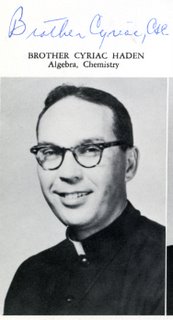
In the seven years that I taught high school in Mexico City I had a first-day-of-class technique that served we well. It was rapidly evident which of my students would challenge me for authority. I made it a point of asking them something I knew they would not know. In most cases this would settle them down for the duration of the term. I believed that too much personal intimacy with students was bad so I always called them Mr. or Miss. I never had discipline problems. I am not sure I would use that technique now if I had to teach again. It seems that my method involved humiliation. It is only today that I finally thought about it and how as boy I was part of a class that humiliated a kind teacher and pushed him into a nervous breakdown. He was much too kind to retaliate. We should have felt ashamed.
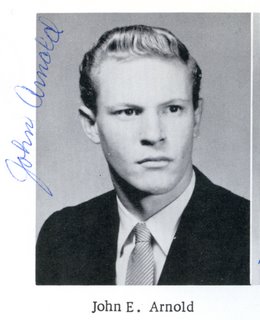
In school while I was not always a model student I always behaved. But in my third year (grade 11) 1959, 1960, at St. Edward's High School in Austin I was not a good boy. In the first and second years (grade 9 and 10) we slept in huge dorms with Gothic celings. We had bunk beds so that the dorms could accomodate 50 of us. There was a separate room within the dorm were our prefect lived. In that 11th grade we had the privilege of living in a room for four with a couple of bunk beds. That grade 11 my roommates were John Arnold, Melvin Medina and Mac Letscher (his parents lived in Australia). That's the order of the pictures here. I was the smallest of the four. John Arnold made it a point to be my bodyguard. He was a member of the football team so few ever tried to bully me. The 11th grade was on one whole floor and one of the rooms was occupied by our prefect, Brother Cyriac Haden CSC who was a soft spoken and very pleasant man. He also taught us chemistry.
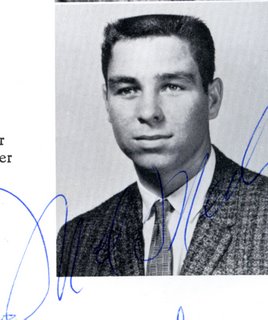
As a teacher and as a prefect we immediately noticed in Brother Cyriac a weakness in imposing discipline. We made it our goal all that year to push him to his limits. In his class (which was right after lunch) I would casually walk in with an unfinished apple or cherry pie on a plate and finish it in class. I told Brother Cyriac that if I ate slowly for a good digestion I simply did not have enough time to finish lunch in the time we were given. I was ejected several times (Brother Cyriac rarely punished us at all) and I was finally barred that year from being a member of the elite and nerdish National Honour Society. We had several of those little cardboard cylinders that when inverted would make the sound of a cat or a cow. We would make these sounds in class and pass the devices around under our desks. Brother Cyriac would try to find the offender. He could never find it as we were too quick. He would then shout and most often say the word we all wanted to hear (the first time I ever heard the word was in his class), "Stop the hullabaloo!" We would all then roar with laughter.
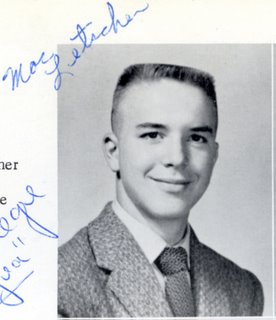
Every morning a huge bell would sound to get us out of bed and ready us for breakfast. Our most important personal mandate was to spend the most time in bed. Duck cuts were fashionable and many of us would spend valuable sleeping time getting the duck cut ready. We four realized this was silly so we all got a flat top haircut. We would face our room sink mirror, put on a bit of crew cut goo ( it think it was called Top Cut) and we would rapidly brush it to perfection in mere seconds.

It was a couple of months into that first semester that the four of us decided to make Brother Cyriac loose his cool. We developed all kinds of stuff to do a slow job of it. We would alternate beds so that Brother Cyriac would not know who was sleeping in which bed when he would check us out at night to make sure we were all in for the night. On other days we would make the four bunks become single beds. One day we put all four beds on top of each other (the ceilings were that high) so that when Brother Cyriac opened the door of our room a whole section of it was empty. Another time we made the room look like a complete mess. When Brother Cyriac poked his head into the room he went ballistic. That's Mac Letscher in his crew cut in our messy room, below.

Then we decided to dye or hair a striking light blue. We kept on with our campaign and I am sad to say that Brother Cyriac disappeared one day and we never saw him again. My guess is that we drove this man into a nervous breakdown. Even then we felt a bit guilty of our deed.
But, today, I reflect on this I as prepare myself to attend and look forward to a high school reunion in Austin in June. I am deeply ashamed at our lack of kindness to a man who always treated us fairly and like the good Christian he was he just turned his other cheek.
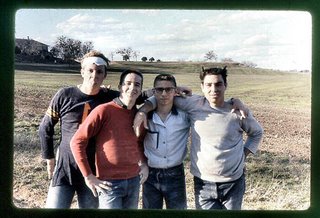
Wherever you are, Brother Cyriac I apologize for myself and for my roommates. We may have meant all we did to you. We simply did not know any better.
Addendum
Another regret from Lee H. Lytton Class of 61
I too had many moments of guilt about the way we treated the poor man. He died long ago and is buried along with Bro. Francis, Bro. Hubert, and a couple of others in the cemetery at the end of Woodward at IH-35. Over the years, I've occasionally visited their graves, and in the case of Bro. Cyriac, did my best to apologize to him for being a major asshole.
A Meccano - A Searing Flash From A Christmas Past
Thursday, December 25, 2008

Yo siempre te tengo presente, pero en un día como éste vos y yó hemos sido grandes protagonistas de esa hermosa ilusión de Navidad, a nuestro regreso de la misa de gallo.
¿cuántos regalos inexplicables? Nunca me voy a olvidar de tu "meccano" con ese motor eléctrico. Alex, te mando un gran abrazo para vos Rosemary, tus dos hijas y tus nietitas, esas flores que son orgullo de tu cámara fotográfica.
wenci
The above Christmas email from my first cousin Wenci from Argentina opened in me all kinds of memories of extremely hot Christmas Eves as I watched the snow fall last night. My granddaughters Rebecca and Lauren opened their presents. I had been unable to convince anybody (a joke of mine every Christmas) that we had to wait until midnight to open the presents. Rebecca could see through it all and simply said, "We are either going to open them before the Christmas portrait or after."
My cousin Wenci's email is accurate in every respect except for that Meccano. It wasn't a Meccano. My mother had somehow obtained from someone at the Buenos Aires American Embassy a much better (and cooler) American Erector Set invented by A.C. Gilbert. It came with that electric motor that so impressed Wenci and I remember making a walking (it really only rolled) robot that I affectionately called Gilbert after the inventor. Here is Wenci's email translated:
You are always in my thoughts but on a day like today, you and I, have been protagonists of that beautiful illusion that is Christmas when we would return from Midnight Mass.
How many unexplainable gifts? I will never forget that Meccano with its electric motor. Alex I send you an abrazo to you and Rosemary, to your two daughters and to your two flowers, your granddaughters who are a pride of your camera.
Abraham Rogatnick told me he felt too frail to come particularly when he looked out of his window and saw all that snow. His presence was palpable at the dinner table as I had cooked without onions. Abraham is alergic to them. Even Rosemary did not put onions in her trademark stuffing for our large roaster chicken.
My son-in-law Bruce Stewart was working late into Christmas Eve so his side of the family was represented by the presence of his mother Marjorie Stewart (in the photos here she is on the right). In the second picture, which was really the first one I took that evening (with b+w Polaroid), I attempted to include our cats. Rosemary is holding Toby and I my female Plata who was not in the least happy. After one exposure that was it. The second picture is better as we are not worried about the cats. I am wearing a plastic crown that came in the Christmas crackers that Rosemary buys at VanDusen every year.

Today is a perfect day to do nothing and to somehow try to incorporate in my mind the memories of those hot Christmas Eves in Buenos Aires and the sense of loss that they will never return. For me, every Christmas is like dying a bit. Something is taken away to be lodged into the back of my head only to be brought back as a searing flash by an unexpected email. I wonder if my father thought about it in the same way? Did he also think that Christmasses are the occasions in which we adults prepare fond memories for our children so that some day they will be in the same sad/happy situation I find myself now?
Christmas to me is watching (but more so listening to the sounds of) Rosemary carefully wrapping all those presents and then seeing the very same presents torn open with the wrapping all but ignored. Christmas is a time to be sad. And as far as I can figure out that seems to be an altogether good thing.
The Prince Of A Professor & The Man In Birkenstocks
Wednesday, December 24, 2008
My friend Graham Walker and I listened to Johann Sebastian Bach's Cantata BWV 36 at the Chan last night. The first line sung jointly by soprano Suzie LeBlanc, alto Laura Pudwell, tenor Colin Balzer and baritone Sumner Thompson:
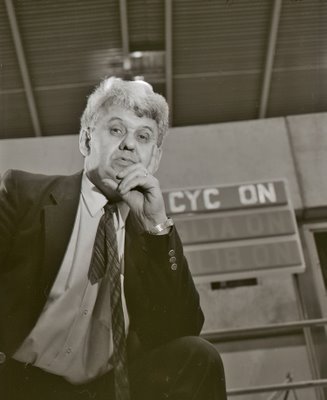
Schwingt freudig euch empor zu den erhabnen Sternen (soar joyfully aloft amidst the starry grandeur) made me think of a possibly unlikely meeting between two men who were present. One of them was wearing extremely casual clothing and his trademark socked Birkenstocks, the other, a Kodiak bear of a man with white hair, was sitting two persons away from us. I found this extreme urge to loudly greet him in the following manner (and I did), "Dr Vogt how is your cyclotron?" He looked at me with a smile and said, "It's doing just fine."
The two students sitting between us and Dr Erich Vogt asked me, "What's a cyclotron?" Luckily I was able to answer a vague, "It's a particle accelerator and this man headed UBC's TRIUMF for years." I really wanted to answer stuff like, "He deals with particles called charmed quarks. A cyclotron is a donut-shaped chamber that accelerates electrons, protons and other particles at extremely high speeds. When these speeds reach relativistic speeds (nearing the speed of light) then you have an out-of-phase problem and that is why particle accelerators are now not circular but miles long." For more on the extraordinary Dr. Vogt read below:
Erich and the KAON Factory
Erich Vogt and Kaons: The very political particles that weren't to be Canadian
By Eve Savory CBC News
Last Updated: Monday, May 5, 2008 | 2:27 PM ET
This weekend, three Nobel Prize winners and dozens of other scientists of the first order blew into Vancouver for a physics symposium — and a party.
Forty years ago, TRIUMF, Canada's national laboratory for particle and nuclear physics, was established and that alone is reason for a physicist to celebrate
But that's not what drew Carlo Rubbia, Dick Taylor and Walter Kohn to the gathering at the University of British Columbia (UBC). It was friendship for the man who co-founded TRIUMF — a man who never won a Nobel Prize but who has worked with some 30 winners, and a man celebrated for his commitment both to science and teaching.
Professor Emeritus Erich Vogt has taught 5,000 first-year physics students over the last 43 years.
Vogt is 78, and according to his students, a prince of a professor. Writes one at Ratemyprofessor.com: "This man is AMAZING. He got his PhD in Princeton in the 50s and had lectures of ALBERT EINSTEIN — !! not mentioning his OTHER Nobel Laureate friends!!"
"Incredible prof. about 200 years old and he's been teaching for free since he was 65," enthuses another.
"All other lecturers should sit in on some of his classes to learn how to teach," scolds a third.
For more on this man read the rest of this delightful CBC interview by Eve Savory here
I thought of Dr Vogt and José Verstappen the man in the Birckenstocks. Verstappen has headed Early Music Vancouver for at least 28 years. Such is his perseverance, intelligence and his knowledge not only of what people will like but what people should like that he was able to fill the Chan on the evening of a snow storm. His followers (I am, unabashedly, one of them) trust his taste for music and we attend his concerts(his society hires local musicians and mixes them in groups with musicians from abroad) all beautifully announced by the Early Music Vancouver Calendar that is mailed once a year and that my Rosemary magnets to the fridge. Verstappen could have lost his shirt last night considering that musical director and violinist Marc Destrubé hired the three best natural trumpet playes in North American to contribute for two of the Cantatatas (BMV 171 and BMV 248/6 Part VI). And there was the participation of those baroque oboists Washington McLain and Sand Dalton (not cheap, I am sure!). The band included many of the members of the Pacific Baroque Orchestra including the three-week mother Glenys Webster playing the viola while a violinist friend kept her thirsty Oscar Robin at bay backstage.
Verstappen did not lose his shirt and we all went home satiated with extremely good Bach. Driving home I thought of the musicians hugging each other and congratulating each other after the concert. I felt frustrated. I am not a musician. I can never be part of that club of people who can do that remarkable task of reading music and transfering that knowledge to an innanimate object made of old wood. The handshakes of the musicians are to me like the secret handshakes of a Masonic order. I can never share and can only watch from the outside. I looked at Dr. Vogt during those cantatas and I am sure that the elementary particle man can see into Bach and read into the meaning of the notes. It was plainly evident on his face. Perhaps there is a relationship between music protons and neutrons that Dr. Vogt is able to understand.
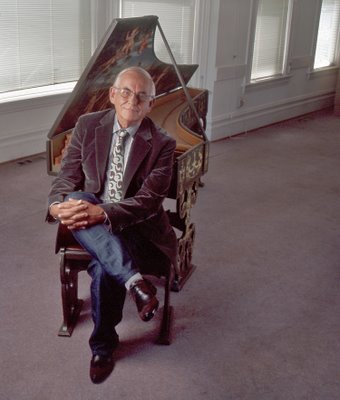
From my vantage point as an outsider I can only assert on this Christmas eve that I am lucky, and that indeed we in Vancouver are lucky to have these two men in our midst.
Even with all the snow and the cloudy skies I don't have to be a musician or a particle physicist to soar joyfully aloft amidst the starry grandeur.
Lauren’s Sundae Hat, Therese’s Sturdy Legs, & A Coat Hanger Angel
Tuesday, December 23, 2008

Guest Christmas Blog by John Lekich
There is a thick blanket of snow on the ground the day Alex and I are set to meet Bernard Cuffling – the veteran Vancouver-based actor who plays Clarence the angel in the Arts Club production of It’s a Wonderful Life. Since I walk with a cane, snow has a tendency to make me a little grumpy. In my boyhood, seasoned gentleman used to tackle their sidewalks with homemade wooden shovels inspired by the business end of a snowplow. But old-school shoveling etiquette has fallen on hard times. Some people shovel and some people don’t - which makes for very uneven progress when you’re working with a personal ambulatory system that mimics one of Alex’s vintage tripods. My eyes are constantly fixed on the ground, watching for sudden changes in terrain. My legs stiffen up in anticipation of a sneaky patch of ice. It has a way of taking all the wonder out of gently falling snow.
Still, the afternoon proves to have a few unexpected compensations. On the way to our interview, Alex makes a side trip to pick up his two granddaughters from school. While we wait for Rebecca’s class to return from an ice-skating expedition, Lauren chats away in the back seat. She is wearing a wool hat with a pom-pom that makes her head look like the top of a strawberry sundae. The pom-pom moves from side to side as she tries to remember the French word for chicken. She moves on to politely explain why she likes grape Jello better than lime. I ask her – rather non-committally – if she has played in the snow. “Yes!” she says, drawing out the word so that it ends with a sizzle of excitement.

When we arrive backstage at the Arts Club on Granville Island, we get a nice surprise. “Look who I found!” says Alex. It’s Therese – a former Railway Club bartender whose easygoing charm never failed to delight us over many a long-lost Thursday lunch. Every once in a while, she would wear a tastefully abbreviated kilt over dancer’s leotards. Instantly melting the heart of the most callous barfly every time she ventured from behind the beer taps. In the middle of an icy winter, I would often envy the artful sturdiness of her legs. Alas, Therese Hartwig has long since abandoned mixology to wholeheartedly immerse herself in the more pragmatic aspects of theatrical life. When she throws her arms around my down-filled parka in greeting, she is wearing the kind of efficiently drab jumpsuit favoured by garage mechanics. Nevertheless, I find myself wishing that I was wearing a much thinner coat.
My joy at seeing Therese again is matched only by meeting the gentlemanly Bernard Cuffling for the first time. I have been watching him in a long string of plays – starting with his 1975 debut in the Arts Club production of My Fat Friend. Originally from England, Cuffling has the kind of face that would look perfectly at home merrily toasting a reformed Ebenezer Scrooge in the Alastair Sim version of A Christmas Carol. As Alex takes Cuffling’s portrait, the actor is still wearing Clarence’s downy pair of angel wings. He will keep wearing then until the end of the play’s unreservedly successful run on January 3rd. I ask how it feels to wear the wings and he explains that they are held to his shoulders by a simple arrangement of coat hangers. “Do they stay on?” I ask. “Oh, yes,” he assures me. “We tried a lot of experiments. But it’s the only thing that really works.”
For some reason, I find this coat hanger idea both comforting and inspiring. If something you find in an ordinary closet can successfully support such a wholly celestial concept as angel wings, any number of small miracles are possible. It’s a thought I cling to as I make my way to Alex’s car without incident. On the way home, the snow is lit by streetlamp. It streaks by in an endless ribbon - the dazzling white of an angel’s wing.
Food For Thought
Monday, December 22, 2008

A cartoon in the Vancouver Sun this week had a sentence that began with, "I should have went..." Rosemary told me that since it is in the vernacular it will soon be correct. I am not sure it is correct now and I wonder if the artist of the cartoon knew better or just didn't. I suspect he didn't and that the cartoon was not vetted by the folks at the paper.
In my photography classes at Focal Point and at Van Arts I have students who tell me they want to be fashion photographers or photo-journalists. Others tell me they want to shoot architecture or food. Some say they want to shoot for magazines. Whichever way you look at it, as things stand these days, I would say there is no immediate future in any of these specialized fields of photography. This is not because my students are not good enough to compete. They are competent and some are very good. The problem lies in the visual standards of web magazines and the fact that hard copy magazines are paying less and less.
In my career in Vancouver I have avoided fashion because fashion in a city with little catalogue work (when I came Eaton's and the Bay did local catalogue work) means that after a couple of months of fashion fame, like a comet you will be over the horizon and replaced by the next one. Fashion is the kiss of death in Vancouver. For many years the tabletop food and beverage photographers did extremely well. The work of Deryk Murray comes to mind. He became prosperous enough to buy a bank on West Hastings by the Cenotaph and converted it into the best photo studio in town. Then the bottom fell out in the industry and Murray left town, (for a while).
Shooting food and whiskey bottles with expertise is not easy. One needs all sorts of lighting resources. The investment in this kind of photography is expensive. It is as expensive as the photographers who shoot architectural interiors and are faced with the problem of not only making vertical columns in walls seem parallel but they must also balance interior lighting with the exterior. The photographer will need many powerful and expensive lights. The advent of digital means that a photographer can now shoot the exterior and the interior in separate exposures and then seamlessly meld them together. You would never know. But in order to make those parallel columns look parallel the photographer has to use an expensive 4x5 view camera and equip it with an even more expensive digital back if he or she hopes to compete in the diminishing market.
My blog is a photo blog that specializes in portraits. I will bang on my own drum and point out that I am very good at it. I try to post photographs that are well taken and well lit. I will sometimes show garden shots but I have to admit I am an amateur. I would really never show you classical architecture shots because I have never been an architectural photographer. I am not Roger Brooks, one of the best of Vancouver's architectural photographers. The food shot here has a purpose. Let me explain.
I will be the first person to state that I believe in good journalism. I believe in journalism written by journalists who studied their craft in school. I abhor citizen journalism. I believe that just because anybody can "publish" their opinion on line; it does not necessarily mean that it will be good. It generally isn't. Citizen journalists have ruined many a web-based magazine with their caustic rants. For a taste of that just look at the comments section in the on-line Globe & Mail.
Where this citizen journalism really shows its amateur origins is in the realm of local Vancouver food blogs. If you look at any of the pictures you will be hard-pressed to find one that shows food in an appetizing manner. More often than not the food looks like stuff that is extruded from animals after their digestion. Shooting food is not easy. Shooting food to make it appetizing is not easy. Shooting food with a little or expensive digital camera that is unassisted by intelligent lighting will simply not work.
I had to shoot the food picture you see here for a magazine that insisted that I do it. I took the picture at Monk McQueens in False Creek. For the picture I used a portable boom light stand so that I could suspend a largish soft box over the piano. Had I used an in-camera flash or available light the food would not have looked good.
I think that I can give my opinion on the photographic side. On the writing side I can only assert that most of the food writing in food blogs does nothing for my appetite. Vancouver used to have James Barber but we still have Christina Burridge, Jurgen Gothe, Jamie Maw, Angela Murrils and a few others. Writing about food to make one want to go immediately to partake of it is not easy. A. J. Liebling, between meals, would have plenty to say about that.
It has never been so evident how difficult that is. Just look at the food blogs. I may not be a good judge of the writing side of it but the photographs suck.
Una Navidad Colorada
Sunday, December 21, 2008
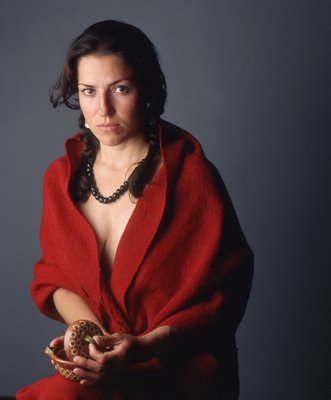
rojo, ja.(Del lat. russus).
1. adj. De color encarnado muy vivo, que corresponde a la sensación producida por el estímulo de longitudes de onda de alrededor de 640 nm o mayores. U. t. c. s. m. Es el primer color del espectro solar.
colorado, da.(Del lat. colorātus, de colorāre, colorar).
1. adj. Que tiene color.
2. adj. Que por naturaleza o arte tiene color más o menos rojo.
Real Academia Española © Todos los derechos reservados
Red and green are the colours of Christmas. Those who are religious say that red represents the blood shed by Christ to save mankind. Snobs might say that the month-long Roman Saturnalia decreed for December 25, AD 274 by Emperor Aurelian as natalis solis invicti ("birth of the invincible sun"), a festival honoring the sun god Mithras is the real origin of red. The reason is that at about the same time, the Church Fathers likewise set the official date for celebrating the birth of Jesus as being December the 25th. And since Christmas was appropriated from the Saturnalia by early Christians, when Italians celebrated Christmas in the 19th century the world copied the colours of the Italian flag. I think this reason is far-fetched and the most likely one is that the fat man wears a red suit.

In Spanish we have two words for red, colorado and rojo. Both words come from the Latin. In Mexico rojo is used more than colorado. In my native Argentina the higher classes look down on the lower classes who use the crass sounding rojo while they the patricians opt for the more melodic colorado. Off colour jokes in Spanish are chistes colorados and dirty old men who are more likely to tell them are called viejos verdes or green old men.
The most brilliant red I know is the vegetable dye red coloured Mexican rebozo my mother was given by her sister Dolly in Mexico City in 1952. It is made of a very rough cotton (Rebecca refuses to wear it saying it makes her itch).
Mexico City at Christmas is not a white Christmas but it is a cold one. It was particularly cold in the 50s and 60s when I lived there as few houses or apartments had interior heating. I remember my mother wearing the red rebozo when she went to the Mexican Christmas posadas which are parties that mimic the act of the Virgin Mary and Joseph looking for a place to spend the night when Jesus was about to be born. The party goers sing outside of the party house for entrance and are denied several times until they are finally let in and the festivities begin. That red of my mother's rebozo screams Navidad to me.

But I have used it to dress up and undress models since I first came to Vancouver 35 years ago. For the last four years I have taken it as a prop for my nude class at Focal Point. My students are dazzled by the colour and the fragrant scent of olinalá. Olinalá is a tropical tree that grows in Olinalá in the state of Guerrero. I have a chest made of the sweet smelling wood and I store my mother's collection of Mexican rebozos in it.
Here are but a few of the women who have worn that red rebozo. In order of appearance it's Ivette Hernandez, Linda Lorenzo, Jennifer Froese and the last one I have long forgotten her name. The colour negative has deteriorated and she moved when I took this exposure.
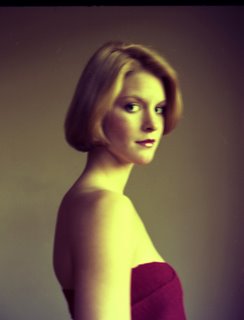 Even though I am unable to clear out the yellow I like it. Perhaps because it was the first time I took out my mother's rebozo from the olinalá chest for a photo.
Even though I am unable to clear out the yellow I like it. Perhaps because it was the first time I took out my mother's rebozo from the olinalá chest for a photo.Every year I wrap the bottom of our Christmas tree with the red rebozo. In our home it is the real colour of Christmas.
shack-es-pear-eh
Saturday, December 20, 2008
"At Christmas I no more desire a rose
Than wish a snow in May's new-fangled shows;
But like of each thing that in season grows."
William Shakespeare from Love's Labour's Lost
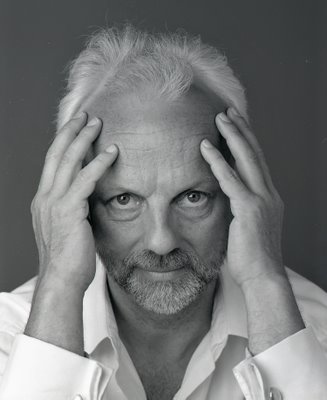
I picked this particular portrait of Christopher Gaze because it is somber. In these times even Christmas seems a tad somber as is Shakespeare's quote on it. While this Christmas blog (there will be others) isn't as happy as it could be it does cheer up in the end.
I a not an actor and I was not born in England but I do think I may have some nice things in common with my friend Christopher Gaze. Both of us are married to beautiful women. Both of us read the morning paper, with breakfast in bed with our wives. Both of us keep Harold Bloom's Shakespeare - The Invention of the Human handy by the bedside table.
But I would like to brag about one thing that I cannot share with my Shakespearean actor/director friend. And this is that for two years in Mexico I lived on Calle William Shakespeare. When I took cabs home I had to pronounce the name
My interest in Shakespeare began there. My mother would explain to me the significance of the man and even quoted the bard in her melodious mezzo-soprano. I remember seeing Leslie Howard and Norma Shearer in Romeo and Juliet back in Buenos Aires when I was 9. In 1966, again in Buenos Aires I took my girlfriend Susy to see the film and she found the acting stilted and the actors too old. Even though I enjoyed seeing Franco Zeffireli's version (with much younger actors) with my mother in Mexico City in 1968 Romeo will always be Leslie Howard. In the same way that Bard On The Beach will always be Christopher Gaze.
Every year Rosemary and I attend at least two Bard on the Beach plays and our companion is Harold Bloom's book. At the theatre lineup we wise up to what we are going to see.
Success is not seen well in Vancouver. Only those organizations which are struggling are admired. If they happen to declare financial problems they are derided and ignored. Success is confusing to Vancouverites. Christopher Gaze and Bard on the Beach have done their fair share of struggling. I view their success as one of the features that makes our city the liveable city it is supposed to be. Rain or shine we can count on our Shakespeare every year. We can depend on having our minds and eyes challenged and like Harold Bloom says, we become better humans for it. That Christopher Gaze married a fine woman who keeps him running (no more Sir John Falstaff!) and that they are happy together bodes well for our city's Shakespearean future. Christopher Gaze, Jennifer Gaze, Bard on the Beach, more success in the coming years and a Merry Christmas. Not that they need any wishing for success. As that famous Spaniard wrote:
A proverb is a short sentence based on long experience.
Miguel de Cervantes Saavedra
Henri Cartier-Bresson Befriends Fred Herzog & Lifts My Ennui
Friday, December 19, 2008
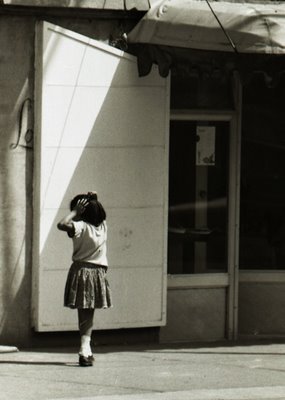
I have never been able to find the wonderful story (in a Penthouse Magazine) that I read some 25 or more years ago about Domenico Scarlatti being time machined into a modern times Los Angeles and how he abandoned his harpsichord and became a member of a rock band. My search into Google today to find that story only got me this which is my own blog from March 17 where I mentioned it
Yesterday I was invited to a pre-Christmas gathering in the studio of Van Arts on West Hastings. I arrived a few hours late but early enough to watch projections of the digital images taken by many of my students. The photographs were sharp, had good composition, and some were most interesting. But in the end I became bored, and not necessarily, because the photographs were boring but perhaps simply due to the cynicism of an old man who has seen too many pictures and taken too many in his time. I heard another teacher near me say, "I just cannot get excited over photographs that don't elicit an emotional response in me."
I am not going to label my excellent students as boring or state that they take pictures devoid of feeling. That would be unfair. I felt confused but I wanted to keep silent in their presence. They were cheerful and excited. I explained that I was a tad bored and within a few minutes one of my students, Patrick Young told me, "Alex you should lighten up." I countered with a, "Telling me to lighten up is like telling a nervous person to relax. It just doesn't work." But the smile on his face was almost catching.

I had a chat with a much older photographer, Alan Jacques, whom I taught some years ago at Focal Point. He is a very good street photographer. He showed me some of his work which had appeared in a reputable photographic book. I looked at him in the eye and thinking of Domenico Scarlatti in Los Angeles going bonkers over a Moog synthethizer I asked him, "Do you think that if Henri Cartier-Bresson were brought back from the dead and brought to our present world that he be able to sell his photographs? Would anybody notice them?" I was afraid of Jacques's answer. I was right. He replied, "He would be ignored."
As remarkable as Cartier-Bresson's photographs are and if you add to that the knowledge that to my generation (the pre-digital camera generation) his photographs are embedded in our memory, the fact is that when he was taking his photographs few had cameras and took pictures in the street.
From my vantage point I divide photographers into two types. There are those who with camera in hand go out and look for pictures. They walk, they fly, they ride bicycles and when they see something that strikes their fancy (it could be funny, serious, whimsical, scary, ugly, beautiful, graphically arresting, etc) they take the picture. These photographers react to a situation that can either be an accident or one that they think will happen if they wait. In a border-line of this category would be the great landscape photographers like Ansel Adams who waited for the perfect light and discovered and or adapted methods of improving that light through negative processing control and master photo printing.
In the other category are the photographers who don't wait for decisive moments. They create them and more often they create them in a studio where they can control the light and their subjects. I am a minor member of this second category. But all photographers dabble in both categories. Some do both well others choose one or the other and then specialize.
The advent of the all-in-one digital single lens reflex has changed the playing field. You can take some pictures at 100 ISO and then, at will, shoot others at 3200. You can take all photographs in colour and convert any into b+w if you want. You can further get b+w infrared results(with relatively inexpensive programs like Paint Shop Pro, that mimic it to perfection. Pre-digital age the photographer wanting to do all that would have needed several cameras and lenses and facing the impossibility of reacting to a situation with more than one of them!
The ability of the DSLR to react to any situation, with ample help from the human holding it, gives the photographer a sense of comfort and control even if it is a reaction, after the fact, of what has been noticed that has to be recorded or "captured" by the sensor.
What that means is that we are getting tons of bad, good and even excellent Cartier-Bresson "decisive moment" pictures that are in bold and sharp colour. After seeing a few of these projected, ennui sets in.
Vancouver's Fred Herzog has at long last received recognition (before his death, and yes he is still alive, and he went on record to point that out!) for his work in capturing a Vancouver long gone, with the Kodachrome. Those colours, the neon the places that Herzog photographed are gone and the same thing can be said, almost, about that Kodachrome. There is no way that modern digital cameras can take anything that remotely looks like Herzog's photographs. Perhaps Cartier-Bresson in our contemporary Vancouver would admire and become Herzog's friend. Perhaps both would go out and shoot in colour.

In 1963 I roamed the streets of Mexico City alone or with friends. We had cameras. They were early SLRs, Pentacon-Fs, Edixas, Pentax S-3 and Exaktas. The lenses we used were of questionable optics. Our light meters if dropped became innacurate. They had springs and moving parts. We took pictures of anything that we thought was interesting. Most of our pictures were boring or were badly taken and or cropped with no sense. The picture that leads this blog is version 3 of a negative I took in 1963. I have scanned it three ways here. It replicates what I originally did in the darkroom. Back in 1963 I had yet to discover the pleasure and discipline of cropping inside my viewfinder. I opted for cropping the negative with my enlarger. You see here how that image progressed. In this last, at the bottom, is the roof of the car on the other side of the street. I must have been behind it. I did not have zoom lens and was stuck with the lens on my camera.
I am almost sure that had I run into someone like me now, then, I would have been told how my work was sloppy, unsharp, unimaginative and plain boring. My students now have far more challenges to face than I did then. Film technology was hit or miss and when pictures turned out we said just that, "They turned out!" as if it were a miracle. Now images are captured routinely and unless there is some digital malfunction they turn out every time. The pressure is on originality. It is this pursuit, originality, with competition from so many that makes 2008 and 2009 so much more difficult than 1963.
My inability to give any sound advice to my students makes me sad and helpless. It makes me jealous of that Penthouse Scarlatti who did just fine with that Moog synthethizer in LA and never looked back at his crude harpsichord and the music of his past. Perhaps my students as they look at their future with a smile on their face know something I don't know. If they are right this is indeed a good thing.
Maggie Langrick At The Helm Of The Artistic Ship
Thursday, December 18, 2008

Recently the Vancouver Sun announced the hiring of Maggie Langrick as the new Arts Editor.
In July 1987 I photographed a 16-year-old Margaret Langrick (above) for a profile by John Lekich for the Georgia Straight. Lekich had already written about her two years before for the Globe & Mail when the actress had appeared in director Sandy Wilson's (below right) debut and BC smash hit film My American Cousin. I photographed Langrick in the garden of her mother's house somewhere in the Westside. For years I have been asking Lekich, "Whatever happed to Margaret Langrick. A couple of days ago I found out that the Vancouver Sun had hired a new Arts Editor called Maggie Langrick. I wondered. But this time around I didn't ask Lekich. I asked that infallible oracle of modernity, Google the question. The reply was instant:
From: WikiAnswers Q&A the wiki way
Q: What ever happened to Margaret Langrick?
In: Authors Poets and Playwrights
Answer
Margaret is now known as Maggie Sansom, and she writes for "Echo Memoirs". Here is a link, with a recent photo of her.
Echo Memoirs.
I gather that Maggie Langrick, Margaret Langrick and Margaret Sansom are all the same person. I guess that Langrick has had extensive experience in public relations. This bodes well for the Vancouver Sun as they need all the positive public relations they can get these days with the declining opinion that people over 25 have of these hard copy web pages we used to call newspapers.
In the 35 years I have lived in Vancouver I can recall two arts editors who were effective even if one of them was not, strictly speaking, and arts editor. Whenever Max Wyman was at the helm as either and arts editor or a Saturday Magazine editor things were hopping. When Charles Campbell created Queue after having had a difference of opinion with the powers at the Straight his creation was instantly called "a real magazine" by my wife Rosemary who knows everything. The rest of the arts editors are a blur in my mind. To be fair perhaps they may not have obtained the backing our authority from above or "management" as Campbell called them. The Tyee's David Beers did the same as Campbell did for Queue for the interesting, challenging and appealing Saturday Mix which disappeared as soon as Beers left via his boss's exit to the Chewing Gum Capital of the US.
Since Langrick took the helm as Arts Editor I have already noticed that a piece on Ballet BC's trouble with their roommate, the Scotia Bank, that was prominently covered by the Globe was ignored by the Vancouver Sun.
If you only stop to think and notice that organizations like:
Ballet BC, the VSO, the Vancouver Opera, the Pacific Baroque Orchestra, the Vancouver Recital Society, the Playhouse, the Arts Club Theatre Company, the Vancouver East Cultural Institute, Gateway Theatre, Theatre Conspiracy, Arts Umbrella, Kidd Pivot, Lola Dance, Karen Jamieson, the Museum of Anthropology, the Vancouver Art Gallery, the Bill Reid Gallery, the Equinox Gallery, Diane Farris Gallery, Bau-Xi Gallery, the New Music Society, the Kay Meek Centre, the Turning Point Ensemble, the UBC School of Music, the Electric Theatre Company, Early Music Vancouver, Goh Ballet, EDAM, Brief Encounters/Solo Collective, Movent/Dances for the Small Stage, Bard on the Beach , Coastal Jazz & Blues Society, and many more galleries, theatre companies, musical organizations, dance companies and all sorts of yearly festivals like the Vancouver Festival or art crawls and many more that I may have forgotten all advertise in the Vancouver Sun you would think of a situation similar to that of the rhinoceros and the oxpecker or askari wa kifaru . One needs the other. If one is healthy so will the other be healthy.
The same can be said of author and book reviews. Publishers and book festivals also buy ad space. Why is it that we cannot have at least one book review per day insted of a paltry few on a Saturday?
I cannot understand why it is that our Vancouver newspapers seem to:
1. Categorize the arts with food (turkeys for newbies), fitness and style/fashion.
2. Consider reviews important in a city where the lack of real review competition makes a review close to useless particularly when the review is that of a last performance. Its been years since I would read of the rivalry between Les Bewley and Alan Fotheringham. Now that was fun!
3. There is rarely that in depth preview explaining for example that if Ballet BC wants to mount a ballet by the famous American choreographer William Forsythe (something Ballet BC did many years ago when cutting edge Forsythe wasn't so famous but our very own John Alleyne knew what was good for us as he indeed did) a sum of upwards of $85,000 in royalty fees has to be paid plus an assistant choreographer has to be brought to Vancouver for supervision (air fare, hotel, etc!). A good pre-view prepares a performance for a viewer. It can inform, educate, inspire and even sometimes persuade a person to turn off the TV and purchase a ticket for a performance.
On a lark I went to a Turning Point Ensemble concert featuring Olivier Messiaen's Quartet for the End of Time. I had not liked Messianen's choral works in the past and even though this was not one I was reluctant. The performance was one of the most satisfying of the year for me. Like Vancouver Opera's recent production of Eugene Onegin this sort of stuff does not happen often in Vancouver. I talked with Vancouver Sun's musical critic Lloyd Dykk today about the Messiaen and his one word comment was, "Sublime." Dykk did not go to the concert. Perhaps he did not know about it. Probably the reason is that one critic cannot go to everything. It is my feeling that in a "one newspaper town" the newspaper should have more than one music critic, several dance critics and theatre critics and at least one critic who specializes in painting and sculpture.
One solution to the lack of sufficient critics and reviewers is to hire freelancers. The newspaper does not have to spend on health plans, dental plans, etc. In a city where architecture plays such a large part of our life I believe that the only architecture writer is The Tyee's Adele Weder. If true, that is an outstandingly embarrassing fact.

I wish Maggie Langrick all the best in what is going to be a tough job. It is my hope that she will help make our city newspaper into a viable one that promotes, explains, educates and reports on its rich artistic milieu. If the newspaper fails, both it and our art organizations will flounder and perhap sink. Sandy Wilson's floating deck chair will not help the sinking of the cultural ship.
What would be the first priority on a possible arts agenda? I would convene a meeting/party with all the publicists and marketing directors of the arts organizations of our city and suburbs (consider that excellent Surrey Art Gallery and North Vancouver's Presentation House) to discuss ways of promoting the arts. The Vancouver Sun could stipulate deadlines for press releases and requirements for handed in images and art. The Sun should consider that if several newspapers in town use the same images to promote the opera (as an example) this will diminish interest. Original art, while more expensive can be more effective. I would also invite all the public, city, provincial and private funding organizations that give money to the arts to also discuss possible strategy.
In the time of Brooks Joyner at the Vancouver Art Gallery and Jim Delgado at the Maritime Museum I remember that they had lunch every month (sometimes with the then director of the Museum of Anthropology) to discuss joint shows. It was not too long ago that the Presentation House had a show of the photographs of Robert Frank (The Americans) while the Pacific Cinemateque projected Franks avant-garde films. With the cross referencing boon of computers, arts organizations have to organize and work together.
We still don't have a detailed schedule or plan as to what local talent the Vancouver Olympic Committe is planning for 2010. I saw a fabulous Chinese fan dance at the Goh Ballet. I am thinking that the Vancouver Opera's Native Canadian slant on Mozart's The Magic Flute would be an obvious pick. Anosh Irani's Indian plays shown at the Arts Club, the Playhouse production of Kevin Loring's Blood Mixes Inside My Heart should be a must. Many of the brief but funny and interesting dance sketches of Brief Encounters or Dances for the Small Stage would be economical to perform and they would be popular to children, too. BC based plays like the Ruby Slippers production of Trout Stanley would show how good theatre is here. Another option would be the Electric Theatre Company's play Studies in Motion: The Hauntings of Eadweard Muybridge by our young playwright Kevin Kerr.
We have an active new music society and performers like Peggy Lee that get recognition in the NY Times but are all but invisible in Vancouver. We have the Pacific Baroque Orchestra and the Vancouver Symphony that comission work to local and Canadian contemporary composers.
Is VANOC considering these options? Is the Vancouver Sun investigating this?
Julia Margaret Cameron - I Was In Transport Of Delight
Wednesday, December 17, 2008
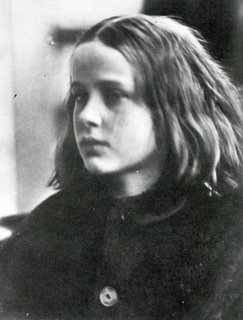
This stunning modern looking portrait of Annie Philpot, which reminds me of photographs of Anne Frank, was taken by the Victorian lady Julia Margaret Cameron (1815-79) in 1864. Cameron was perhaps the most famous and influential portrait photographer of the 19th century. She was criticized by the males of her profession (and interesting, too, so were the abominable canvasasses produced by the young Ipressionists in France) for being smudgy or out of focus. The fact is that Cameron had very sharp eyes and she chose to rack her lens into focus and then unfocus it to her tastes even after her son Harding taught her how. She settled on the Isle of Wight in 1859 when she visited Lord Tennyson and fell in love with the island. She bought two properties (her husband Charles Cameron had coffee and rubber plantations in Ceylon) and named one of them Dimbola Lodge.
It was at Dimbola in December 1863, that Cameron, then aged 48, was given a camera by her eldest daughter, Julia, and husband, Charles Norman. Before actually owning what was an expensive and cumbersome piece of equipment, Cameron had been involved in various aspects of the photographic process - printing negatives and photograms, compiling albums as gifts, posing for photographs and helping to stage compositions. The gift marks the beginning of what would quickly become her all-encompassing application to the 'art' of photography. Setting up the coal store as a darkroom and the glass-enclosed chicken house as a studio, she began her single-handed photographic investigations fervently, annotating a portrait study of Annie Philpot as 'My first success' (the picture above left) which she took in January 1864. Of this first success Cameron wrote about it in her unfinished autobiographical manuscript (1874) which was not published until 1927:
Having succeeded with one farmer, I next tried two children, my son Harding, being on his Oxford vacation, helped me in the difficulty of focusing. I was halfway through a beautiful picture when a splutter of laughter from one of the children lost me that picture, and less ambtious now, I took one child alone, appealing to her feelings and telling her of the waste of poor Mrs Cameron's chemicals and strength is he moved. The appeal had its effect and I now produced a picture which I called My First Success. I was in transport of delight. I ran all over the house to search for gifts for the child. I felt as if she entirely had made the picture. I printed, toned, fixed and framed it, and presented it to her father that same day: size 11 by 19 inches. Sweet, sunny haired little Annie! No later prize has effaced the memory of this joy, and now that this same Annie is 18, how much I long to meet her and try my master hand upon her.

albumen print, oval, April 1867
Julia Prinsep Stephen (née Jackson; formerly Mrs Duckworth) (1846-1895), Wife of Sir Leslie Stephen and mother of Virginia Woolf and Vanessa Bell. She sat for Cameron 8 times. This woman is the niece and goddaughter of Julia Margaret Cameron and, like her, a member of the artistic circle which gathered at Little Holland House. She was a renowned beauty and a favourite of the Pre-Raphaelites and sat for Burne-Jones, as well as G. F. Watts and her godmother. From her second marriage to the historian, Leslie Stephen, she was the mother of Virginia Woolf and Vanessa Bell.
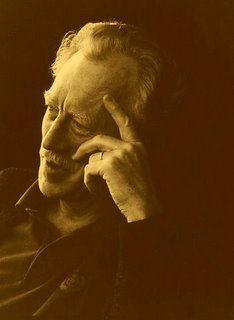
The Cameron print, above, left, has a complicated explanation and the sitter a long pedigree. My photograph of Swedish actor, Max von Sydow, right, does not carry such a lengthy explanation. While I photographed him later with my lights I took this one with a long, 250mm lens with my Mamiya on a tripod in the Sun Room of the Hotel Vancouver.
Nuts ( & Schlossed) Over Melted Cheese
Tuesday, December 16, 2008
Sunday night was Hilary's birthday. She is Rebecca and Lauren's mother and my youngest daughter. We had a cheese fondue. For dessert Rosemary prepared a Mexican flan served with whipped cream. Our drink was fresh-squeezed mandarin orange juice. The event brought to mind another years before.

The Swiss gentleman and his son sat at my table in Burnaby some 29 years ago to partake of my Swiss fondue. Rosemary thought I was crazy and predicted a disaster. I did point out to her that when my father had moonlighted as a translator for the Indian Embassy in Buenos Aires he had invited the embassy staff to our home for curry.
I was 8 or 9 and I had never seen Bombays before as my mother, and Filipinos, call all Hindus. Hindu with a t at the end is a terrible four letter word in Tagalog so that's why Indians from India are Bombays in the Philippines.
The Swiss gentleman, Mr. Broennimann had been the CEO of Nestlé in Mexico when both my wife and I had taught his son André at an American private school around 1970. Andre (Andy) had decided to study at UBC and his father was visiting.
For once I was able to prove my wife wrong as Broennimann père and Broenniman fils argued on only one of the ingredients. It seemed that the father objected to my use of nutmeg while his son argued that in some Swiss cantons nutmeg was the norm!
My adventure and taste for cheese fondue had begun in 1970 when my daughter Ale's godfather, Andrew Taylor gave us a fondue set for Christmas. In Mexico I was hampered by the strict Mexican prohibition on imported cheeses. I had to make do with whatever I could find. At first I had several disasters where the mixture would curdle until I started mixing a tablespoon of corn starch with the white wine and poured the mixture into the aluminum caquelon (my pot was not an authentic Swiss earthenware pot).
Only once did we try the other variety of fondue, a meat one. We accidentally knocked over the pot on our dining room table and we were lucky not to have been burned.
Andrew's fondue set was made in Mexico and it is a combination of copper and brass. There is no insulation between the alcohol burner and the fondue frame so the whole setup gets incredibly hot. Every once in a while I forget. I touch to move it at the table and suffer from the experience with temporary loss of the finger prints of my right or left hand. Every time this happens I swear to throw the set away and buy a modern one. I remember Andrew and his kind gift, and I renege.
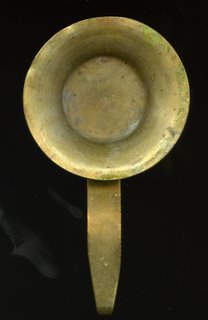
For many years we had pleasant fondues in our Burnaby home. My eldest daughter Ale and I had a routine. The routine was that I was going to everything possible to prevent her from putting out the flame at the end of our meal with the special damper (seen here). Sometimes my daughter would smarten up and she would hide the damper. I would send her off to the kitchen to fetch something and when she returned I would pull out a soup spoon from my back pocket and would do the honours to her dismay. Strangely, Rebecca has not been interested in extending this tradition even though she and Lauren love my fondue.
By the time we moved to Athlone in 1986 Rosemary started cutting carrots, green onions, red peppers, mushrooms and even brocoli for the fondue. We also enjoyed poppy seed bagels instead of a cut up French baguette. Our favorite bread for fondue, besides those bagels is a Georgian baguette we get at Stongs.
Recipe for Swiss Fondue
350 grams Emmenthaler
350 grams Gruyère
222 grams Appenzeller
1 clove garlic
dry white wine
corn starch
kirsch
fresh ground black pepper
I rub my pot with a garlic clove and then I add a bit more than half a glass of dry white wine mixed with a tablespoon of corn starch into the pot at a middle to low heat. Once the mixture thickens I begin to add, little by little, the finely chopped cheese (I used to shred it). I add a lot of freshly ground black pepper and half a couple of pinches of nutmeg. When I am ready to take the pot to the table I add a couple of shots of kirsch. The only brand I have been able to find in Vancouver is the Austrian SchlossKirsch. There are some who say that this is the product singly responsible for the term to be schlossed. This recipe serves four to five guests.
I generally don't reduce the alcohol flame for two reasons. The first is that Andrew's fondue set gets so hot I cannot regulate the flame much. The second is that at the end of the meal there a delicious brown crust on the bottom called la religieuse (a none nicer nun?) which Rebecca and I fight to not share.
A Post-Literate Moment With A Ghost
Monday, December 15, 2008
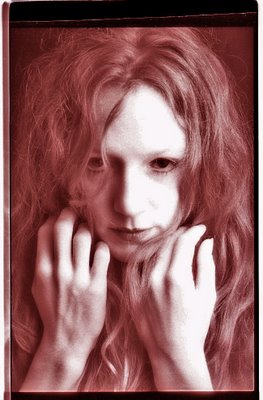 At about this time the NY Times Book Review chooses the 10 best books of 2008. I was happy to notice that one of the books was Julian Barnes's Nothing to Be Frightened Of. I was so moved by the reading of this book that I wrote about it here, here and here. My happiness was short lived. Buried in the little Up Front introduction by the editors, who chose the 10 books, was this startling paragraph.
At about this time the NY Times Book Review chooses the 10 best books of 2008. I was happy to notice that one of the books was Julian Barnes's Nothing to Be Frightened Of. I was so moved by the reading of this book that I wrote about it here, here and here. My happiness was short lived. Buried in the little Up Front introduction by the editors, who chose the 10 books, was this startling paragraph. Once again we have followed up our compilation of 100 Notable Books of 2008 with our list of the 10 Best. In keeping with the "tradition" the Book Review established in 2004, the final choices divide equally between fiction and non-fiction. The fiction list, compressed though it is, conveys the continuing vitality of imaginative prose in this supposedly post-literate moment.
Can that be true that we are living in a post-literate moment, or even worse, post-literate times?
What does one talk about in cocktail parties these days? I have always noticed that when I travel to the US, bars usually have a neon sign that reads cocktails. Have we superseded the term cocktail to the less glamorous drink in Canada? When you go to a party "where they serve drinks" you cannot ask, "What are you reading at the moment?" can you? The right question would have to be something like this, "Do you Twitter?" And if you really want to be the focus of the party you would answer, "Not only do I Twitter but I also vlog (video based blogging)."
I would be banished (pronounced in three syllables with a mock Christopher Gaze Shakespearian English) since I do not know the difference between a Rob Roy and a gimlet nor do I Twitter (I tried it for a day and became bored), Facebook, Flickr or MySpace. It is amazing how verbs so suddenly transitive can be so close to the concept of the Aristotelian Unmoved Mover. They are impacting our language for the worse.
Vancouver Poet Laureate, George McWhirter is in the process of translating Homero Aridjis's Los Poemas Solares which is the latest (2005) book of poetry by that favourite Mexican author of mine. Until McWhirter finishes you will have to live with my poor translation of this poem that has been much in my thoughts as I think of Julian Barnes's Nothing to be Frightened Of. As I have mentioned before Aridjis is probably as agnostic as Barnes but because he (Arijdis) is a poet and Barnes is not he (Aridjis) has license to believe in ghosts.
Recommendations for a Ghostly Existence
When you walk on the street, don't kiss your loved one,
besides not seeing you, you might scare her.
When you are run over by a car in traffic,
don't worry, it will have driven over air.
In a room with a nude young woman, don't be anxious,
your desire will be the beating of an empty heart.
If at daybreak the cat is staring at you, don't pet her,
her flashing eyes are seeing nothing.
If your dog crosses you without knowing that you are there, you don't
fret,
It will have seen a ghost calling it from the other side of the light.
Recomendaciones para la vida fantasmal
Cuando vayas por la calle, no beses a tu amada,
porque además de no verte, la puedes espantar.
Cuando en el tráfico un coche te atropelle,
no te preocupes, habrá aplastado aire.
En el cuarto con una joven desnuda, no te inquietes,
tu deseo será un pálpito en un saco vacío.
Si al amanecer la gata está mirándote, no la acaricies,
sus ojos fulgurantes estará viendo nada.
Si tu perro te atraviesa sin saber que estás allí, no te
aflijas,
habrá visto a un fantasma llamándolo desde el otro lado
de la luz.
Los poemas Solares, Homero Aridjis, Fondo de Cultura Económica, 2005 Mexico
My lovely ghost is dancer/choreographer Lauri Stallings
Banging My Own Drum With One Light
Sunday, December 14, 2008
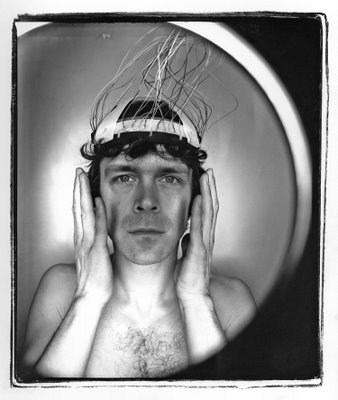
As my job (formerly a profession) as a magazine photographer fades away asymptote-like, I find some small comfort that unlike General Douglas MacArthur I cannot be fired. I am a free lancer. But like him I am fading away as quickly as a poorly fixed photograph. It is a photograph that will become plain dust and not a random dissolution of pixels. Meanwhile I must feed my wife her hot cream-of-wheat with brown sugar in the morning so I need funds. Some of them come from my teaching endeavours. I teach at two places. One is Focal Point and the other is Van Arts. The former has a full-times students program like the latter but it also has photo workshops and 10-week courses. That's where I come in. In the last The Contemporary Portrait Nude class (mentioned here I had 6 students. This was an especially fun and intimate class but not one that will make money for the school. I offered to write an essay promoting my next class The One Light Portrait Photography Course for their Christmas brochure as the class begins in January. Perhaps if enough people read that essay we may get that sweet sum of 12 students, not too big, not too small. The school has two studios joined by doors. I divide my class in two so that in the three-hour shooting sessions there is plenty of time to take pictures. The essay is accompanied by my photograph of Vancouver actor/director Paul Terns which I shot with one ring light.
The One Light Portrait Photography Course
Alex Waterhouse-Hayward
Those who work at Focal Point have a standing joke on the two classes that I teach there. They say one is One Light, No Clothes and the other One Light With Clothes. Joke aside they are completely right. As a magazine photographer in Vancouver for 35 years a great majority of my photographs have been one light photographs. And most recently I have further fine tuned my choice to a 2x3 ft soft box placed very close to my subject while standing near a middle gray wall.
In most situations with the exception of my frequent use of a powerful ring flash, that light has never been an on-camera flash. And therein is the problem as to why so many photographs on the internet in such social sites like Flickr and myspace all tend to look the same. The pictures were either taken with existing light or with an on camera pop-up flash.
The Holy Grail of photography for any photographer with gumption should be to find a personal style. Tethering a camera to a modified light (via either a flash cord or a radio slave) such as a soft box or an umbrella mostly happens in the professional photographer’s studio. These kinds of photographs are becoming less frequent. Learning how to use a modified one light is one way, I believe, of rapidly increasing one’s chances of successfully pursuing that elusive personal style.
The 19th century was limited until almost its end, with photography that depended on existing natural light. As soon as electric lights came in photographers and cinematographers were hampered by slow film emulsion. The bright focused lights they used produced the glamorous and mysterious film noir films of the 30 to the 50s. Then this kind of light went out of fashion and a more uniform natural light (still with powerful light units) came into use. Only recently, as digital still camera and digital cinematography cameras have been developed with ultra sensitive sensors, has it been possible to use them in low light situations without additional lighting. In fact Vancouver Sun film critic, Katherine Monk while reviewing Jonathan Demme’s Rachel Getting Married notes that the film is “Shot on high-definition digital video with little or no apparent artificial light…” To me this means that this will be a gritty film with no lighting style. And that is fine. But when you pay good money to escape financial depression and working angst is this what you need? Is it coincidence that the age of Hollywood glamour films occurred during the Great Depression? Is Rachel Getting Married a trend in more unlit digital films? Will movies soon resemble the images of Flickr?
Choosing to take photographs with no additional lighting should be a choice based on purpose while knowing what the other possibilities are. Learning to use one light, be it a soft box, an open flash, a ring flash, a spotlight or a grid spot light should be part of any photographer’s recipe book towards photographic diversity and the achievement of a personal style.
The class runs Tuesdays from 2-5pm beginning January 13
That Wholesome Girl From Tarzana California
Saturday, December 13, 2008
Bettie Page dead at 85.
Les. Wiseman
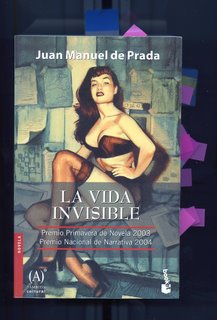
I received that yesterday, understandably, as Wiseman is a fan of the whole genre. My immersion or perhaps awareness of glamour photography, pin-ups and fetish began when I moved with my family to Vancouver in 1975. I swore that when I arrived I would immediately be able to go to any newstand (not so at the time in Mexico City) and purchase a Playboy without feeling guilty or ashamed. This I did. Soon after I found myself being hired (imagine that!) by the folks of the Drake Hotel, Marr Pub, Cecil Hotel and the No 5 Orange to shoot posters to decorate their strip bars. By the standards of today those posters were in good taste, not showing much. I would categorize them as glamour, which curiously is one of the few words in which Americans retain that u. In fact I have two fat folders in my files labeled Glamour I and Glamour II. These two files are within four large filing cabinet drawers labeled Nudes. You see I have taken quite a few nude photographs in my years in this city. But I never indulged in pornography, and not because I didn't try. I discovered that to shoot pornography one has to quench one's innate sense of good taste. Even though I cringe when most people call my nudes by that "oh-so-horrible" epithet, tasteful I have to admit that most of my pictures are tame. If they are tame it is entirely all my fault. I have discovered through the years that a woman's imagination for the erotic is richer, more intelligent and in many cases crasser than a man's. I have been gently urged or pushed by some of my female and some male subjects to go beyond my parameters. In most cases I balked.
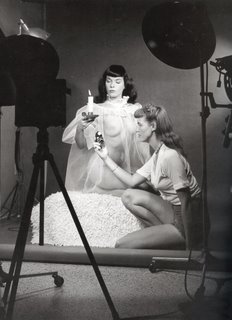
Much of Bettie Page's fame should be attributed to the erstwhile model and photographer Bunny Yeager. Yeager grew impatient at the clumsiness and lack of originality of the male photographers that took her pictures and decided she could do better. She started taking her own pictures (that's a self portrait of Yeager here with Betti Page) and became so good at it that she launched her career as a glamour and pin-up photographer. On the way to fame she took the memorable pictures of Bettie Page with a pair of chettahs while wearing nothing (in some versions) and a tiny leopard-skin swimsuit in others. When Playboy's Hefner invited her into the fold and to travel to Chicago, she decided to stay put in her home in Miami. Her career might have suffered because of this decision.

It was in Yeager's photographs of Page that I discern that wholesomeness that Page is so famously attributed with. Note this from my copy of Bunny Yeager's Art of Glamour Photography (1962 AMPHOTO New York)

The photographer working in the home can use any kind of lighting he prefers: flashbulbs, strobe, floodlights, or just existing light. Let us go now from room to room to show you what can be done with each surrounding.
Wing-type chairs are good for portraits, as the model can peek at you from around one of the wings while she sits in the chair...
Now let's go to into the bedroom. A frilly feminine bedroom of course is more desirable that a plain masculine one. A prop that you might care to buy and keep on hand for such purposes is a quilted satin comforter in some photogenic colour like blue. They don't wrinkle easily and I've found you can even wash them in the washing machine when they get soiled without damaging them pictorially. If you have such a prop, you can change the plainest looking bedroom into one of grandeur... well almost.

Yeager's little book is just like that, charming in its innocent way of a time that we now see as being quite innocent even if it wasn't. As a photographer I had my versions of Bettie Page. Two that stand out are Maddalena di Gregorio, below left and right, and Katheryn Petersen. The former gave me hints of a darker existence of chains and cuffs but I was much too afraid to look in.
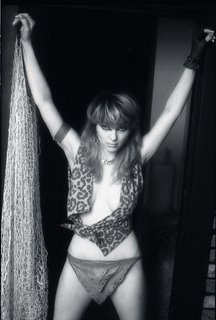
She would smile at me in her generous Italian mother role, almost hiding a much more complex and probably more exciting nature. Or as in the second picture of Maddalena here, she would grow serious and sad and somehow become the universal Flemish Maddona/Eve. It was perhaps here with Maddalena where I lost all hope (gladly) of ever wanting to take pin-up and glamour photographs. Perhaps nobody ever penetrated Bettie Page's veneer of wholesome feminity. It was with Maddalena that I discovered that there was more within and that it was much more arresting.

Katheryn Petersen posed for me many times. She was flexible and easy going with a quick smile that almost made me forget her super-model wide cheek bones and astounding eyes. But every once in a while she would say, "Alex when I show up at the studio just shoot. Don't ask any questions." I did this a few times and once when the pictures involved some tying up I told her, "I feel so sorry for you. You look so helpless!" Her retort convinced me I had no idea about her ways, "That's the last thing you are supposed to say," and she smiled and made me feel comfortable again.
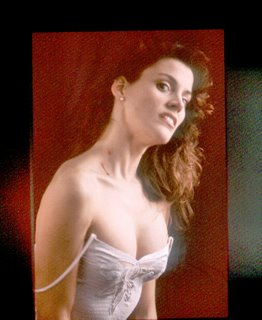
Not that she didn't sometimes scare the hell out of me. Once she became a vampire in my studio. I almost wished I had brought a turtle neck sweater.
In 1956 my mother got her job teaching at the ASARCO (American Smelting and Refining Company) town of Nueva Rosita in the state of Coahuila. She told me of a young bachelor mining engineer she found charming called Juan Jaime. Perhaps I was too shy or Jaime was shy, too, since I don't remember talking to him much. We lived in the American Hotel (that's what it was called) as did Jaime for three years. We had our three meals (home cooked) at the hotel. Next to the dining room there was a den/living room with a magazine rack. Juan Jaime would walk in some days and he added his magazines (he must have been subscribed to them) Argosy, True, Esquire (and sometimes!) Playboy. I would sneak in and nervously look and read them. I distinctly remember reading in True an article on a young boxer called Cassius Clay who boasted that some day he was going to be champion of the world. These magazines (Esquire at the time was a girlie magazine) provided me with my first real glimpses of the female anatomy. My previous experience had been lame Mexican magazines that showed, page after page, pictures of Brigitte Bardot's cleavage. I was far too young to have discerning eyes so I have no recollection of Bettie Page appearing in any of Jaime's magazines.
But now and in the last few years I could not see the women on Granville Street in stark white skin and dyed black hair in bangs with piercings, here and there, not to realize where the inspiration had come.
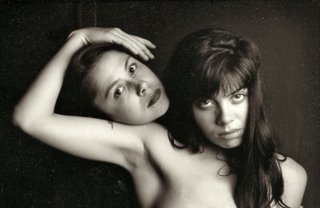
Nor when I first met Bib Naked (seen above with our mutual friend Nina, another muse of mine) quite a few years ago not notice who one of her role models was. Who would have known as I was guiltily looking into Juan Jaime's Argosies that some day I would be teaching a class called The Contemporary Portrait Nude at Focal Point? Thanks to Maddalena, Katheryn and many others I came to understand that you cannot teach nude photography in this century with any kind of justification that would satisfy my inner feelings of what is correct and what isn't. Such a class has to have more.
Four years ago when I went with Rebecca and Rosemary to Buenos Aires my new and modern Canadian sensibilities chafed at looking at toothpaste ads showing women in bikinis with big smiles holding a tube of Colgate. I got into massive arguments with my Irish/Argentine rugby nephews when I protested the stupidity of such ads. They questioned my manhood and thought that Canada had corrupted it. I told them I could not justify the photography of women in bathing suits posing by muscle cars or large motorcycles. I could not tell them that I would even opose modern versions of Bunny Yeager's bikini pictures on a beach (with the blast of that handle mount flash). They would not have recognized Yeager nor would they have known who Bettie Page was.
In my Focal Point class The Contemporary Portrait Nude I emphasize the humanity of our subjects that face our cameras. I have the school hand out my Model Protocol to any new model. My students read it, too. I listen and watch closely how my students talk and deal with the nude models of our class. Our classes run smoothly in what in most circumstances would offer lots of moments for stress and embarrassment. A few months ago in class 9 (there are 10 sessions in each course) one of my students asked a strangely costumed Yuliya what the purpose of the outfit was. Yuliya, below, with that casual but unsettling glance of hers told him, "It's used for sitting on a man's face." Who would have known, even a couple of years ago that one of the segments of my contemporary nude portrait class would be as contemporary as having one themed on fetish? I now find it entirly logical.
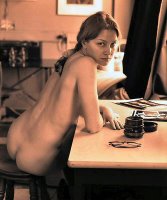
My argument for this is that in spite of Bettie Page's popularizing (all smiles even when she was gagged and tied) this genre called fetish, it really did not achieve a mainstream status until recently. I believe that there are now weekly fetish parties in Burnaby. If they have them in Burnaby ( I dare say this as I used to live there) then it must be mainstream. From Yuliya we have found out that fetish has rules set in stone. "A dom would not do this," she will tell our class, adding, "Only a sub would pose like that."
Not too long ago I saw a French photography magazine in the window of Sophia Books with the delightfully luscious Sophie Marceau on the cover. I bought it. Inside I was startled (not by the Marceau spread) by a photograph that featured a woman from the waist down (wearing brief underwear) who had octopus tentacles wrapped around her long legs and slim ankles. The photograph was in an equally startling bold and sharp colour. I immediately coined the expression and labeled the photograph as "nouveau fetish". What then would replace the tired, structured world of fetish in the 21st century where pornography is so prevalent that even it does not shock anymore?
I believe I have the answer. A few years ago I had one of my favourite models in my studio. At her request we were making some liberal versions of the Audrey Hepburn she adored. This involved elegant hats, long black satin gloves, fishnets and a silk scarf. She was not wearing much beyond that and my studio was cold. My model put on a coat. It was difficult not to notice that it was a man's heavy wollen Herrinbone coat. I asked her, "Where did you get that?" She looked at me with almost no emotion and said, "It is my father's." I took my picture. It is as startling and as scary as the octopus legs. I cannot show it here. But it was then that I knew that any attempt at nouveau fetish has to come from within the model and the photographer. The shock is internal. It is in the glance of the face. It is more subtle without the need for chains, cuffs or fake (and or real) blood.
Would Bettie Page have known this? I am sure she (like my Maddalena) would have known. But good models that they both were, Maddalena is alive and well and living in Milan, they stood their ground and waited for the photographer to discover it and perhaps draw it out. It is the failure of Page's time and of her contemporaries, those male photographers who never seemed curious enough to look further. As for Katheryn? Here she is below with her Bettie tattoo.

The book cover at the beginning of this, La Vida Invisible (2003) by Spanish novelist Juan Manuel de Prada is a fictional story based on the time that Bettie Page (called Fanny Riffel here) dissapeared at the height of her fame in 1957, her private life of three decades, her fight against poverty and mental ilness (she was institutionalized in California after attacking her landlady) and her emerging from it as a born-again Christian. In the novel, too, is the account on how she was summoned by the US Senate committee headed by Estes Kefauver that was investigating pornography. An attendant at the asylum becomes a friend of Page and she talks to him candidly while he makes sure of taping the conversations. All this is investigated and re-told through a Spanish journalist who goes to Chicago to escape the prospect of a boring marriage. In Chicago he meets up with a woman who has fallen for a violinist of the Vancouver Symphony Orchestra, a VSO going through severe finacial times! De Prada's account of our fair city is not a pleasant one:
La calle tenía ese aspecto pulcro, enojosamente pulcro y grisáceo, que los mediterráneos atribuimos a las ciudades suizas; la noche se ahondaba a lo lejos, refugiada en un parque que lindaba con la acera de enfrente, muy escasamente iluminada, a diferencia de la acera a la que se había arrimado el taxi, sobresaltada de farolas que proyectaban sobre el suelo charcos de una luz que parecía la vomitona de un enfermo de paludismo.
The street had a clean and neat look, an upsetting clean neat and grayish, which we Mediterraneans attribute to Swiss cities; the night disappeared into the distance but took refuge in a poorly lit park that bordered the sidewalk across the street while the sidewalk on this side, where the taxi had stopped, was amply lit by street lights that cast puddles of light the colour of the bile of someone suffering yellow fever.
Streaking Meteors Past The Smoking Angel
Friday, December 12, 2008
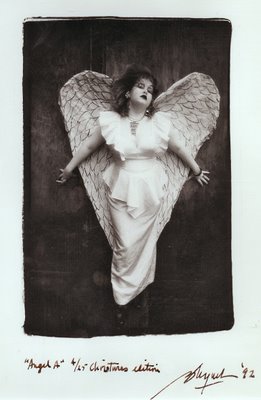
I hate photographs of people with angel wings.
The only one I have ever liked is the one hanging in my den. It was taken and given to me by my photographer friend Brian Lynch in 1992. About three years later, while living in a tepee in Vernon he decided to go and watch a meteor shower. Lynch suffered from diabetes and in a previous accident had suffered a leg amputation. This time around while looking at the meteors streaking across the sky he stumbled and fell. In the hospital he was told his other leg would have to be amputated. We were told that he had a heart seizure, not long after, and died. I have missed this man every day of my existence and particularly when I look up at the angel in my den. I know that the little female angel is holding a cigarette in right hand. I smile.
Lynch was a large, quiet spoken, gentle and kind gay man. His life changed from one day to the next while proselytizing as a Mormon Elder in California sometime in the late 70s. He rang the bell at a house and the man who opened the door smiled and invited him in. It was Timothy Leary. Like Peter the Rock, Lynch left everything behind and became the man I learned to love. He was as good a photographer as I have ever known. He had a penchant for curating exhibitions. It was from him that I learned that big was not better. He told me once, "Alex, I love photographs that are not bigger than 4x5 inches. It forces the gallery viewer to come up close and almost put their nose on the glass. This creates and intimate situation that does not exist with big photographs."
I had a joint show with him at the Helen Pitt Gallery downtown sometime around 1991. A couple of days before the opening he suffered a stubbed toe and went to St, Paul's Hospital. The toe became a gangrenous leg which was then amputated just below the knee. This did not prevent Lynch from showing up to the opening in a taxi.
I miss going to his old studio/loft near BC Sugar. I miss having strong coffee and discussing photography, complete with f-stops, chemical formulas and his trademark Emerson effect for b+w printing. As my friends and I mutually wander off into our private lives I miss Lynch's smile and his voice and most of all those big manly hugs of his.
As I was looking at the angel today I remembered one of my poet friend Homero Aridjis's poems about an angel. He has written many angel poems. Aridjis, while probably at least an agnostic, has a deep belief (because he is a poet?) in angels. This one is one of my favourites.
The Angel Speaks
With words, with colours, in silence
they moved in, gave me wings and hair
locked me into human form.
And now like an mortal
with its silhouette and shadow
I am on the inside of me.
Stonemasons, painters and poets
laboured day and night
to shape me out of their dreams.
I want to escape the body's cage,
take back my original being, that
pure invisibility.
Homero Aridjis from Eyes to See Otherwise
Ojos de otro mirar
Selected Poems
Poem translated by George McWhirter, Vancouver Poet Laureate
Habla El Ángel
Con palabras, con colores, en silencio,
me cercaron, me dieron alas y cabello,
me fueron encerrando en una forma humana.
Y ahora estoy adentro de mí mismo,
con silueta y sombra,
como cualquier mortal.
Lapidarios, pintores y poetas,
trabajaron día y noche
para darme la forma de su sueño.
Yo quiero escapar de la jaula de los cuerpos
y recobrar mi ser original,
el de la invisibilidad perfecta.
The Beauty And The Beast & A Beauty Again
Thursday, December 11, 2008
Flügelhorn, translates into English from the German as wing horn. Purportedly the instrument was used on the battlefield to summon the flanks, or wings, of an army.
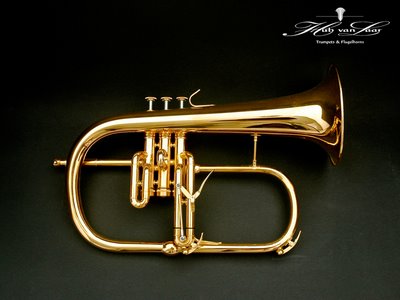
After the performance of the Arts Club Theatre Company production of Disney's Beauty and the Beast directed by Bill Millerd at the Stanley I could not move from my seat. I allowed the much younger audience, including many children and one boy, I know for a fact is 4, to leave. I then waited at the lobby while Rosemary munched on grapes. I was on the lookout for the cool looking Henry Christian. When I saw him I simply asked, "Can you show it to me?" He took me up to a room and opened a case. Inside was the most beautiful red-gold coloured flugelhorn I have ever seen.
The flugelhorn (also spelled fluegelhorn or flügelhorn) is a brass instrument resembling a trumpet but with a wider, conical bore. Some consider it to be a member of the saxhorn family developed by Adolphe Sax (who also developed the saxophone); however, other historians assert that it derives from the keyed bugle designed by Michael Saurle (father), Munich 1832 (Royal Bavarian privilege for a "chromatic Flügelhorn" 1832), thus predating Adolphe Sax's innovative work.
I have seen and heard Christian play the trumpet with the Vancouver Opera Orchestra. But last night, besides the trumpet, he played a flugelhorn. The sound is unmistakable. My first taste for the flugelhorn was in 1962 when I ran home with much anticipation from a record store in Mexico City with a copy of Miles Davis's Sketches of Spain and heard it played with a Harmon mute. After that I bought records with Art Farmer, Chet Baker, Maynard Furguson and Thad Jones. All played the flugelhorn and, yes! (no Chuck Mangione).
I am sure that the children had a great time with that marvelous revolving castle, scary electric-eyed wolves, beautiful costumes, pleasant songs and the S&M performance of "dom", Gaston (Jonathan Winsby) and his "sub", the ever suffering LeFou, (Vincent Tong) who kept slipping on a banana.
We adults, Rosemary and I, enjoyed the first rate performance of singers and actors of this production which features a dance of tankards to end all dance of tankards, a cancan with human spoons and knives, and plenty of leg and saucy cleavage, courtesy of Monique Lund who plays Babette. In less political times she (Babette) would have been called a nyphomaniac. I am glad they (nymphomaniacs), while endangered, are still about.
But as good and charming (and so wholesome, too!) as Belle (Amy Wallis) was, and also her partner the Beast played by Steve Maddock, my eyes followed the crazy antics of Lumiere (a walking candle stick) played by Matt Palmer and the 3cPo(esque) performance of Daniel Arnold, below right, as Cogsworth the talking and ticking, and walking clock. After seeing Arnold in the Arts Club production of Poster Boys I can assert I would go to any play with Arnold in it.

The tone of the flugelhorn is "fatter" and usually regarded as more "mellow" and "dark" than that of the trumpet or cornet. The sound of the flugelhorn has been described as approximately halfway between a trumpet and a horn, whereas the cornet's sound has been described as approximately halfway between a trumpet and a flugelhorn. The flugelhorn has a similar level of agility to the cornet but is more difficult to control in the high register (from approximately written G above the staff), where in general it "slots" or locks onto notes less easily. It is not generally used for aggressive or bright displays as both trumpet and cornet can be, but tends more towards a softer and more reflective role.
But at the end of the night, musical director (and keyboards) Bruce Kellett and his band (Graham Boyle, percussion, Henry Christian, trumpet/flugelhorn, Ken Cormier, keyboards, Neil Nicholson, trombone, and Sasha Niechoda, keyboards) made my day with a sound that was much bigger than the sum of its parts. I had a short chat with Henry Christian after he showed me that flugelhorn. I noted the extremely low and sonorous notes that could not possibly be that of a normal tenor trombone. Trombonist Neil Nicholson plays the tuba and the bass trombone, too. Could he have brought one of those along? It seems not. Nicholson managed to hit those very low notes (the monster was usually doing scary things) and at the same time play very high sounds that blended with the lower and mellower Christian flugelhorn.
A virtuoso performance by the trombonist, the rare and lovely sound of a flugelhorn all add up to an exciting evening for both jaded adults and a respite for children from iPods, computers and special effects.
With both It's a Wonderful Life and Beauty and the Beast , Artistic Managing Director Bill Millerd has assured our city of a continuing Vancouver Christmas tradition for all ages. Let's hope somebody tells him soon of the existence of the Easter Bunny.
The image of the flugelhorn came from the beautiful site of musician and composer Erik Veldkamp
For those wanting to take children note that there are various matinees and some early evening performances until the play closes January 4, 2009. Look here.
A Coil, 49 Traffic Lights, Kingsway & My Goof Cords
Wednesday, December 10, 2008
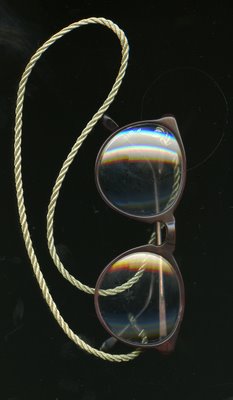
Rosemary is helping out Rebecca with her French science assignments which this month are all about electricity. They are discussing parallel and series circuits. I heard a word I had not heard for years, bobine in French which is very close to the Spanish bobina. As I transversed the city on Kingsway Avenue to Kinsgway and Sperling (49 traffic lights. I counted them and I stopped for at least half of them!) to drop off my broken glasses at All-Canadian Eyeglass Repair, I thought about bobina. This is what went through my memory.
It must have been at least 38 years ago when as a teacher in high school in Mexico City one of my students asked me if I had ever heard of Alice Copper. The whole class laughed at me when I replied, "No, who's she?" I had a very good class and we made a pact that we would try to learn each other's music. Thanks to them I caught on to the Allman Brothers Band and Crosby, Stills, Nash & Young. I taught them about Dave Brubeck, Gerry Mulligan, Mozart and Bach and took them to an old Mexican baroque church to listen to Vivaldi. I remember that one of the pieces was the C Major Mandolin Concerto and the other was a briskly played Gloria RV-589 (just the way I like it).
I was extremely surprised when my class showed up all dolled up in dresses and suits. I was wearing a brand new brown one I had purchased at a spiffy local store on Paseo de la Reforma called Zapico. It was a terrific suit. Halfway through the concert there was lots of rain and an electrical storm. After one very loud bang all the lights in the church went out. One of the street transformers had been blown out. The conductor, a lugubrious looking Italian, told us the show would go on as soon as the waiters in the restaurant next door brought candles. It was a concert that my students and I will never forget. The flickering of the candles on the gilt baroque altar was magical. We decided to celebrate in a cafe in the Zona Rosa. The Mexico City air was fresh and brisk because of the rain and the electrical storm. I was enjoying the clean air by smoking a pipe! As soon as we entered the cafe I slipped the pipe into my upper jacket pocket. A few minutes we could smell smoke. There was a large hole in my front pocket! Smoke was coming out of it. The usual low oxygen content of Mexico City's altitude had somehow received a bonus of oxygen in the storm. I was depressed. A week later after taking my suit to an inivisible mender it was as good as new. It was then that someone told me that I looked terrible in a brown suit.
At about that time I had this state of the art (then) Acoustic Research amplifier that sported an international circuit. It could be used in either 110 or 220 volt household current. It had circuit breakers for protection. During the weekends my amplifier would turn off randomly. I decided to buy a volt meter to find out why . To my horror the usual 110 voltage was hovering close to 200 during the day. During the week the voltage would sometimes go down to 50. I enquired and I was told that the nearby factories in Tlanepantla would not operate during the weekends so voltage would go up. And during the week they would severely test Mexico City's electrical system.
If you ever travel in Mexico City or anywhere in Mexico you will see lots of mechanical shops that feature the word re-bobinado. This means to re-coil. Electrical motors (even those in car generators) work because a coil of thin copper wire surrounds magnets around a shaft. The action of electricity and magnets causes the shaft to turn. Fluctuating voltage makes coils burn out. Think of blenders, drills, refrigerators, vacuum cleaners, etc. It is virtually impossible to have a fridge with its original motor coil for more than a couple of years. You don't throw your appliances, you have their motors re-coiled!
Living in a third world country means that, paradoxically, little is thrown away. It is fixed somehow. This philosophy even translates itself into the consumption of the lowly pig. There are pig snout tacos and pig ear tacos and that list goes on.
There is a bit of that philosophy with the folks that repair my glasses All-Canadian Eyeglass Repair on 6817 Kingsway. I go there cheerfully in spite of those 49 traffic lights.
In a slight detour I would like to point out that I saw my first traffic light in 1952 outside the Retiro train Station in Buenos Aires. It was at the corner of the station and Avenida Libertador General San Matín. The reason I had not noticed it before is that it happened to have been the first semáforo in Buenos Aires.
My glasses besides suffering broken lenses (I always wear glass glasses) have multiple cases of broken patitas(legs) which in English are either called arms or temples. These patitas break because I use goof cords. Why are they called goof cords? My friend Les Wiseman, who taught me the term, says that anybody who uses them looks like one.
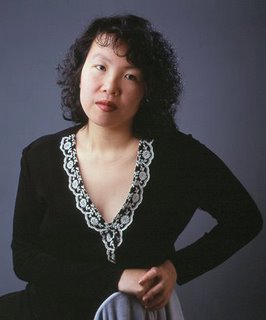
My first experience with broken arms by reason of goof cords was some 12 years ago when writer Evelyn Lau, left, visited me. When she was about to leave she asked me to hug her. There was crunch and both arms collapsed. It has been like that since. If I don't use goof cords, I cannot find my glasses and I squint at my computer monitor.
The folks on Kingsway repair my glasses, usually in less than 30 minutes.They never tell me to throw them away or that they are not worth repairing. While I would not like to experience Mexico City's voltage problems in Vancouver I would like to see more shops that promote the repair of stuff instead of converting into it into land fill.
The Geisha In Armour
Tuesday, December 09, 2008

So many years ago my writer friend Ben Metcalfe had a 50s modern house in West Vancouver that had a brook running underneath it. Behind the house, where the brook came from Metcalfe had built a Japanese garden. He kept the very fine wine he made in the little Japanese hut. Metcalfe (seen here by the brook with his son Michael) had seen the picture of Susanne Tabata (not this one, as this Polaroid surfaced only today, long lost in an envelope). "Alex," he told me, "I want you to convince your Japanese/Canadian friend to pose here in my garden, you know..."and with the wink of his eyes I knew he wanted me to photograph the beautiful woman in the nude. I did ask Susanne Tabata and she did decline, to Metcalfe's disappointment. I managed to convince Tabata to pose for me wearing part of Joe Cohen's armour collection. Joe Cohen had the Sony concession for all Canada, he was a philanthropist and honorary Vancouver Police Chief. Every once in a while I went to him when I needed a broad sword for a shoot that required one. I photographed Christopher Gaze (below, left) as Richard III with the same sword.

To this day I wonder what would have been the result if Tabata had declined the session with the armour and acceded to posing like a Geisha.
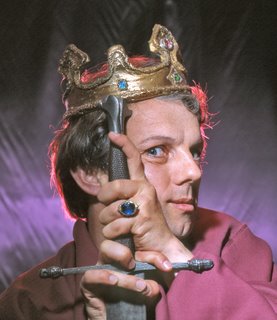
Goethe Said That Architecture
Monday, December 08, 2008
A day of melancholy can only be improved one way. This is by accentuating it.

A trick is to listen to Franz Schubert's Quintet in C Major, D. 956 which he completed shortly before October 2, 1828. A fatal illness overcame him four weeks later and he died on November 18. He alluded to this quintet being his last major work in a letter to a friend, but in fact he wrote Der Hirt Aud Dem Felsen (The Shepherd on the Rock) D. 965 before he died. Both compositions are conveniently in the same CD. Yesterday evening I listened to both, by the fireplace in our den while Rosemary drove Hilary, Rebecca and Lauren home after dinner.
The Quintet has to be just about the most beautiful work of music ever written yet (and that is why it is so good) also one of the most complex pieces of music ever composed, from the point of view of this amateur's ears.
Just a couple of days ago I received an email from my friend, Spanish musical conductor Juan Castelao asking me to check a word in an Homero Aridjis poem. The internet version in English had an error. My book Eyes to See Otherwise by Homero Aridjis and edited by Betty Farber and George McWhirter (Vancouver's Poet Laureate) has the poems in Spanish on one page and in English on the other. The poem Castelao was interested in, Goethe Said That Architecture happened to be translated into English by McWhirter himself.
Goethe Said That Architecture
Goethe said that architecture
is frozen music,
but I believe it to be petrified music,
and cities, symphonies built out of time,
concerts of visible forgetting.
Of sounds and silences wrought
into iron, wood and air, he said nothing,
perhaps he spoke about the places of verb
where we live, and that way alluded
to us language factories.
Musical streets didn't concern him either,
although man slips via these walkable rivers
into old age, love, the night, up to a table, into bed,
like a sonata of flesh and bone.
Goethe Decía Que La Arquitectura
Goethe decía que la Arquitectura
es música congelada,
pero you creo que es música petrificada
y las ciudades son sinfonías de tiempo construido,
conciertos de olvido visible.
De labrar sonidos y silencios
sobre hierro madera y aire, no dijo nada;
quizás habló de los lugares del verbo
en que vivimos, y con eso aludió
a nosotros, fábricas de lenguaje.
De calles musicales no se ocupó tampoco,
aunque por esos ríos caminables
el hombre va a la vejez, al amor, a la noche,
a la mesa, a la cama,
como una sonata de carne y hueso.
The sleeping violinist posed, unknowingly, for my camera around 1962 in la Alameda Central a park in downtown Mexico City. Aridjis's last line, like a sonata of flesh and blood , reminds me of Schubert writing:
The product of my genius and my misery, and that which I have written in my greatest distress, is that which the world seems to like best.
The melancholy isn't entirely gone.
The Shy Boston Brahmin Paints The Town Blue
Sunday, December 07, 2008

In May 1983 I read in the Vancouver Sun that there was going to be a stripper convention, the Golden G-Strings, in Las Vegas" in June and that Vancouver, famous for athletically inclined ecdysiasts ), was going to be represented. I knew that I had to find a way of going to Las Vegas. It was far easier than I thought. I called Western Airlines (it existed then and it flew Vancouver/Las Vegas. I told the PR department that Maclean's was sending me to the convention. They told me I would have a ticket waiting the day the convention started. I called the Province and talked to the Sunday Magazine (in those days it appeared on Saturday) editor and told him that Maclean's was sending me to Las Vegas. "$1000 for story and picture," he told me.
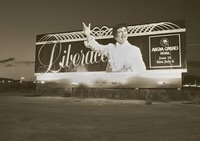
Armed with the Province assignment I called Maclean's and told them I was going for the Province. "One thousand for short blurb and pictures." I flew to Las Vegas first class (the first time in my life) and when I arrived at the Sahara, the convention hotel, I was given $15 per day journalist rate.
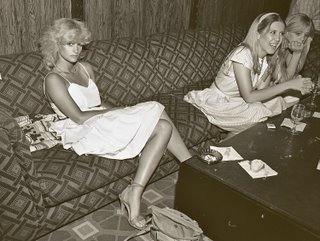
In three days I took almost one thousand photographs. On the first morning I photographed the strippers who were registering. There were loud ones, fat ones, thin ones coming from all parts of North America. I greeted the Vancouverites. There was one elegant but quiet and shy woman in a white dress sitting in a sofa. I snapped a few pictures of her. During the convention I noticed that she was shunned and she kept to herself.
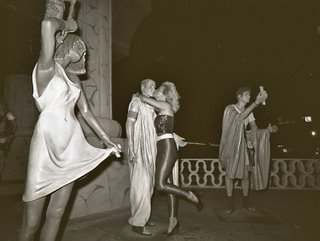
I will not write here how it was that I became a judge and sat with fellow judges, burlesque legend Tempest Storm on one side and a Las Vegas mafioso packing heat in his shoulder holster on the other. On the last afternoon I approached the shy stripper and asked her why she kept to herself. The moment she opened her mouth I knew why.
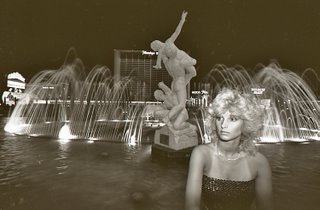
She sounded like President John Kennedy dressed in drag. She had that Boston Brahmin accent. "The other girls think I am stuck up, but I am just shy," she told me. She added, "I haven't had much of a good time."
I have long forgotten her name but I had a proposal for her. "How would you like to walk on the strip with me and have a strawberry daiquiri at each major hotel? " She smiled and said, "Yes, wait a bit while I change."

She appeared a few minutes later dressed in electric blue tights, a skimpy top and high pumps of the same colour. As we walked on the strip we heard all kinds of tire screeches, brakes. Many cars stopped to yell at us perhaps blaming us for their near accidents. I felt like a million dollars and could not believe my good fortune. On the way I managed to take a few pictures. They are not very good as the daiquiris began to take their toll. Sitting at the hotel bars we watched the attendants slip large fresh strawberries into the blender. We would have rejected anything artificial. I explained to her how the drink, properly spelled and capitalized as Daiquirí was the name of a beach near Santiago, Cuba. I wanted to say Cuba so that she would repeat it with that Kenneydyesque r at the end! I told her how the drink (without strawberries) had been a fave of both Kennedy and Hemingway.
We returned to the hotel in a taxi. At the lobby she thanked me for the evening. I felt like a boy scout who had done his duty. She said, "I really had a good time."
I never saw her again.

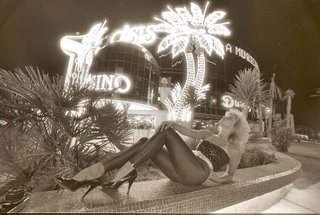
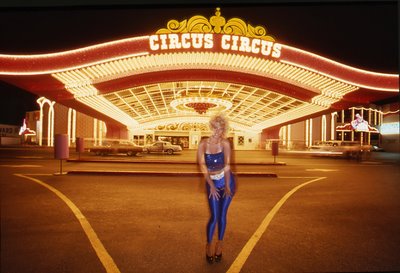
Postcript
A couple of months later, the evening of August 31 I was in bed alone. I was depressed. It was my birthday and Rosemary had gone to New Dublin, Ontario to visit her parents. I called up a few of my friends. They weren't home. For years I have hated my birthday so I don't tell anybody about it. Since they don't know they don't wish me a happy birthday. By the time I called my friend Ian Bateson I was so low in spirits that I sang to his answering machine, "Happy birthday to me, happy birthday to me..." I went down to the kitchen knowing I would find fresh strawberries in the fridge. I made myself a blender-full daiquiri, and in one of the few times in my life I almost drank myself into oblivion. I was almost levitating on the bed (it felt like that) feeling no pain thinking of luscious blondes in electric blue tights. I heard a noise at the front door, "Happy birthday, Alex, I decided to fly home early because I did not want you to be alone." When she noticed in what state I was she became angry and was instantly sober and guily.
The Virtuoso Violinist, The Tall Mexican Conductor & The MIT Professor
Saturday, December 06, 2008
In my Friday NY Times I found this:
In the preface to his only novel, "The Picture of Dorian Gray", Oscar Wilde famously proclaimed that "all art is quite useless." The statement seemed so intriguing to a contemporary, an Oxford University student named Bernulf Clegg, that in 1891 he wrote Wilde asking him where in his other work he "may find developed that idea of the total uselessness of all art."
Wilde, not directly answering Clegg's question, responded: "Art is useless because its aim is simply to create a mood. It is not meant to instruct or influence action in any way. It is superbly sterile, and the note of its pleasure is sterility."
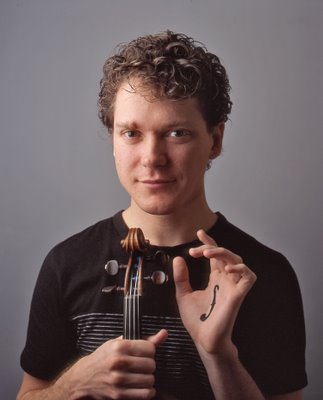
I would not agree at all and, furthermore, I am not qualified to equate art with culture. A statement on culture by an MIT professor (below) is more of my idea of the role of the arts and culture in society.
Amidst all the attention given to the sciences as to how they can lead to the cure of all diseases and daily problems of mankind, I believe that the biggest breakthrough will be the realization that the arts, which are conventionally considered "useless," will be recognized as the whole reason why we ever try to live longer or live more prosperously. The arts are the science of enjoying life.
John Maeda
Muriel Cooper professor of media arts and sciences at the Media Laboratory of the Massachusetts Institute of Technology.
I first included Maeda's little gem here. I also wrote about the quaint and delightful Vancouver tradition of access here. This is after performance access, to the general public at backstages in theatre, ballet and opera, at the Queen Elizabeth, modern dance, the VSO at the Orpheum and if you are insistant (but not too agressive) even after performances at the Chan where one must navigate past large men dressed in black.
I wrote about "that door" on stage right at the Orpheum in that link above. This last Monday Hilary ( my daughter and Rebecca and Lauren's mother) went through that very door to chat with violinist Corey Cerovsek. Nobody stopped us particularly since we didn't ask. The ghosts of other performers I have chatted or photographed back stage always haunt me ever so pleasantly. And there was Corey delighted to see us. "At one time legions of people would file in. Now this trend has almost disappeared," he told us. Cerovsek's two encores besides featuring a Bach violin sonata included an extremely difficult piece, a de force, I had never heard of. Cerovsek wrote down what it was for me.

The very tall (I calculate 6 ft 2 ) and very light-skinned Mexican guest conductor, Carlos Miguel Prieto (prieto means very dark-skinned), was there. He had directed the evening's performance of Verdi's Vespri Siciliani Overture, Sibelius (with Cerovsek as soloit) Violin Concerto in D minor op. 47 and Bartók's Concerto for Orchestra with lots of precision, great energy and with an obvious delight. Thanks to Prieto I discovered that indeed Bartók had a great sense of humor and was not the scary composer I thought he was. I chatted with Prieto and Hilary got to practice his Spanish with him.
As Hilary and I left after such a pleasant evening I could not but recall Maeda's words:
The arts are the science of enjoying life.
Before that concert I had enjoyed Cerovsek's comment on the b+w version of the photo above which I placed here.
Hello Alex!
With the computer perched a little precariously on the windowsill I pick up
a signal generously donated by the fine folks at the Safeway Credit Union...
fine and QUICK work there you've done! I find it's an excellent continuation
of the series. And not at all Hitlerjugend-y. (We'll await final word from
Lucy in Paris.) The more I look at this morning's picture, the more I enjoy
it... I'm visually tickled by the counterpoint of stability and motion in
the area around my hands. The solidity of the right hand leads one to the
frozen grace of the scroll of the violin, from which you trip over the
curves of the left hand with that F-hole dancing leaf-like in midair, down
the forearm to begin the loop again; my elbows hint at a triangle with the
center of my face, and for some reason it all makes me think of that classic
Escher drawing with the reptiles...
http://faculty.smu.edu/cwsmith/Escher_1.jpg
Harmony and melody in your composition. Very musical! It's almost as though
the spirit of juggling were silently in the air before my chest.
Three little comments. Lucy and I aren't actually engaged. (Marriage has
become quite passé in France, I believe.) My mother might be a bit shocked
to hear that we were. You have a typo on "preclude". And you might enjoy
knowing that Lucy and I have a purple magnet on our fridge quoting a line of
Thomas Beckett:
L'habitude est une grande sourdine
Waiting for Godot, I believe. Somehow perfect as it invokes the habit that
you write about while "sourdine" is what string players call the mute we
sometimes use... Lucy had the magnet before we met, so I think the latter
association is coincidental. But considering that a mute affords another
tone color to a player, and therefore to me has no negative connotation, it
suggests a cheerful interpretation: habit can also be a beautiful thing!
See you tonight,
Corey
The Little Sister
Friday, December 05, 2008
Vivian: So you do get up, I was beginning to think you worked in bed like Marcel Proust.
Marlowe: Who's he?
Vivian: You wouldn't know him, a French writer.
Marlowe: Come into my boudoir.
The Big Sleep (Howard Hawks, 1946, with Humphrey Bogart, Marlowe, Lauren Bacall, Vivian).
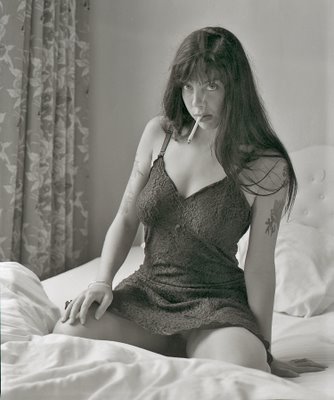
lay on my back on a bed in a waterfront hotel and waited for it to get dark. It was small front room with a hard bed and a mattress slightly thicker than the cotton blanket that covered it. A spring underneath me was broken and stuck into the left side of my back. I lay there and let it prod me.
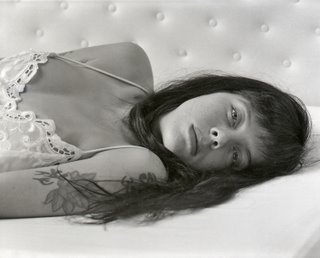
The reflection of a red neon light glared on the ceiling. When it made the whole room red it would be dark enough to go out. Outside cars honked along the alley they called the Speedway. Feet slithered on the sidewalks below my window. There was a murmur and mutter of coming and going in the air.
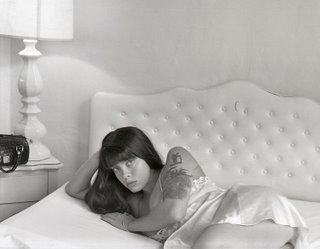
The air that seeped in through the rusted screens smelled of stale frying fat. Far off a voice of the kind that could be heard far off was shouting: “Get hungry, folks. Get hungry. Nice hot doggies here. Get hungry.”
-- Farewell, My Lovely (1940)
Moths Fluttering At My Kitchen Window
Thursday, December 04, 2008
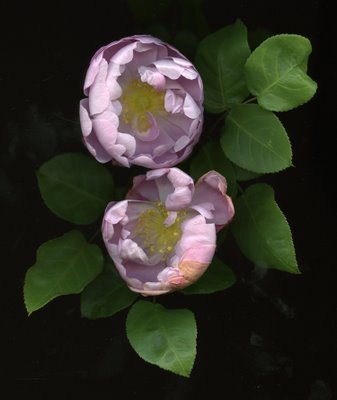
These days as I look out the window of the guest bathroom or out the kitchen window (by the sink) I see little moths fluttering and trying to get in. It could be the light or the warmth they sense is on the other side of the window. They are insects at the end of their cycle.

They remind me of other animals I have seen in the throws of death. For all of us this an exit we take alone, Hollywood scenes of Lionel Barrymore dying in bed surrounded by his loving family to the contrary. The fluttering of the moth's wings even reminds me of the little vibration in the body of a fighting bull moments before it dies on the sandy arena after it has been pierced by the matador's sword. In that huge arena of cheering people the 600kg bull seems small and pitifully alone. It dies surrounded by thousands of spectators. Is it any different to the shocking image of a dying crow in my garden as its wings like that moth's flutter and then stop?
Sow bugs and other bugs die by the thousands in my garden unseen, but those little moths hit home and sadden me. They are so persistent, trying to live for a few minutes or seconds more.
As the moths fade away I try not to go to the garden. The cold repels and the mush of my hostas as they fade into the ground is a sobering and unwelcome sight. But today I ventured outside anyway and I was rewarded by English Rose Coverdale. There were two blooms that had managed to open. And Rosa 'Ghislaine de Feligonde' while not in bloom sported beautiful new foliage that contrasted with the reddish older leaves. Those very leaves might have little holes next spring as the offspring of those little winter moths chew their way to an eventual confrontation with my kitchen window.

I momentarily forgot about my lonely moths but not forgetting that my own turn by the window in winter will come.
Cricket and Prorogation
Wednesday, December 03, 2008
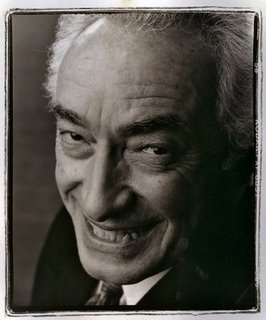
While I may be a Nationalized Canadian I have lived almost as many years as I have been in Canada in places like my native Argentina and my adopted Mexico. I am alien to the concept of a parliamentary democracy. My attempt to understand it has never gone past the concept of "losing confidence". On the other hand if parliamentary democracy is a British invention (English, perhaps?) how is it that the French and the Italians seem to have lots of governments going up and down with no-confidence votes.
My concept of no confidence is simpler.
1. It can be a statement by a four-star general reading a decree, "Our country has lost all confidence in this government's ability to govern. We feel that unless we intervene to impose order our homeland will fall into chaos."
2. The simpler no confidence vote is a bullet in the head of the failing leader.
As I grapple to understand what is happening to my Canada I have come to the conclusion that understanding politics of the parliamentary kind is no different from trying to figure out the rules (and even the purpose) of cricket. I often say that the French figured out their grammar after inventing wine (four times twenty plus six to say eighty six?) and the Germans did the same but with beer. My guess is that parliamentary democracy came to being during a primitive cricket game in which the players were tipsy on meade.
As I read about a coalition of three parties and a possible prorogation I was confused by the term. I looked it up and found the English meaning to mean this in Wikipedia:
A prorogation is the period between two sessions of a legislative body. When a legislature or parliament is prorogued, it is still constituted (that is, all members remain as members and a general election is not necessary), but all orders of the body (bills, motions, etc.) are expunged.
In the British and Canadian parliamentary systems, this is usually due to the completion of the agenda set forth in the Speech from the Throne (in the UK, called the legislative programme, and also "the Queen's Speech"). Legislatures and parliaments, once prorogued, remain in recess until summoned again by the Queen, Governor General, or Lieutenant Governor, and a new session is begun with the State Opening of Parliament and the Speech from the Throne.
My confusion lay in that in Spanish to "prorrogar" means to extend not to delay as in English. I looked it up in my RAE Dictionary and was surprised that while both the English and Spanish words come from the same Latin root, it is the secondary meaning in Spanish that is the same as in English which is to delay or suspend. But knowing that does not mean I understand parliamentary democracy any better.
I remember taking the portrait of an interesting politician, Mel Hurtig(above, left) in 1993 who was heading the National Party. In elections that year Prime Minister Kim Campbell lost to Chrétien. Part of Hurtig's party platform is imbedded in my brain as he explained it to me in a most excited manner gesticulating with his hands as if here were a Latin American. It was this:
An important platform in the National Party's campaign was the idea that electoral campaigns should be funded by individual Canadians each contributing a small amount each year, thus taking away what the National Party considered was the undue influence of large, multinational corporations funding political campaigns.
For years after I kept receiving mail from Hurtig. I have always remembered him fondly as a good man, no better and no worse that some of the other Canadian politicians that have faced my camera. But I suspect that he would not have approved of any of the current shenanigans. But whatever these shananigans will bring I am now, confidently, a Canadian and I know there will be no bullet to anybody's head.
Below is part of Chapter One of one of Patrick O'Brian's Aubrey/Maturin novels, The Fortune of War . It is about a cricket match played by Captain Jack Aubrey, R.N. and his crew of the Leopard against the Admriral Drury's Cumberlands on the port of Pulo Batang in the Dutch East Indies in 1812. The match is initially won by the Cumberlands but in the end an inexperienced Doctor Stephen Maturin (Captain Aubrey's surgeon and a great Irish hurler) saves the day. Most of the chapter is alien to me and I have never understood exactly how it is that Doctor Maturin comes to save that day!
The match began precisely on the hour, by Admiral Drury's watch: Jack won the toss, and elected to go in. The game was democratic, to be sure; but democracy was not anarchy; certain decencies were to be preserved; and the Captain of the Leopard , with his first lieutenant, led the way, while the Admiral opened the proceedings, bowling downhill to Babbington. He took the ball from his chaplain and polished it for a while, fixing the lieutenant with a steely glare; then taking a skip, he bowled a wicked lob. It pitched well up outside the off stump, and Babbington played back, but as he played, so the ball broke in towards his vitals, and jerking back further still he spooned the ball neatly into the Admiral's hands, to a roar of applause from the assembled Cumberlands.
'How is that?'said the Admiral to the chaplain.
'Very pretty, sir,'said the chaplain. 'That is to say, Out.'
Babbington returned, downcast. 'You want to watch the Admiral,' he said to Captain Moore, of the Leopard's Marines, who succeeded him. 'It was the most devilish twister you ever saw.'
'I shall play safe for the first hour or so, and wear him out,' said Moore...
The Leopards are losing so Midshipman Forshaw comes to summon Stephen Maturin who is working in a nearby hospital:
'Oh pray sir, come on, 'cried Forshaw over his shoulder. 'The Admiral is skipping up and down: and we are in a dreadful way. Mind the branch, sir. Nine wickets down, and only forty-six. Mr. Byron got a duck, and so did old Holles.'...
...Jack [Aubrey]came to meet him, and said in a low voice, 'Just keep your end up, Stephen, until your eye is in; and watch out for the Admiral's twisters,' and then as they neared the Admiral, 'Sir, allow me to name my particular friend Dr. Maturin, surgeon of the Leopard.'
'How d'ye do, Doctor'?' said the Admiral.
'I must beg your pardon, sir, for my late apperance; I was called away on-'
'No ceremony, Doctor, I beg,' said the Admiral, smiling: the Leopard's hundred pounds were practically in his pocket, and this man of theirs did not look very dangerous.
'Shall we begin?'
'By all means,' said Stephen.
'You go down to the other end, 'murmured Jack, a chill coming over him in spite of the torrid sun.
'Should you like to be given a middle, sir?' called the umpire, when Stephen had walked down the pitch.
'Thank you, sir,' said Stephen, hitching up his waistband and gazing round the field, 'I already have one.'
A rapacious grin ran round the Cumberlands: they moved much closer in crouching, their huge crab-like hands spread wide. The Admiral held the ball to his nose for a long moment, fixing his adversary, and then delivered a lob that hummed as it flew. Stephen watched is course, danced out to take it as it touched the ground, checked its bounce, dribbled the ball towards the astonished coverpoint and running still he scooped it into the hollow of his hurly, raced on with twinkling steps to mid-off, there checked his run admist the stark silent amazement, flicked the ball into his hand, tossed it high, and with a screech drove it straight at Jack's wicket, shattering the near stump and sending its upper half in a long, graceful trajectory that reached the ground just as the first of La Fleche's guns, saluting the flag, echoed across the field.
Anosh Irani's Father's Fiat
Tuesday, December 02, 2008
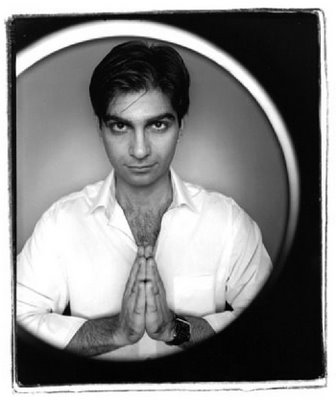
Friday night, I was driving to the Vancouver Dance Centre. CBC's As It Happens was on the radio and they were interviewing Mumbai-born Vancouver author and playright Anosh Irani. I have photographed Irani and I have sat next to him at the theatre. I can attest to the fact that he is a gentle and quiet spoken man. He was talking to the folks at the CBC from his home. He was working on his next novel so the reporter (Carol Off, perhaps?) inquired if he was going to insert the situation in Mumbai in his novel. Irani answered that he was working on a journalistic piece (the essay below, perhaps?) and that he was having a hard time grappling for objectivity and trying to supress his emotions. He stated that this was most important. Did he succeed?
Flowers for the Taj
By ANOSH IRANI
Mumbai, India
AS I watched the Taj Mahal hotel breathe fire, I remembered my grandfather, Burjor. For more than 30 years, he was the florist at the hotel, ordering roses flown in daily from New Delhi.
Like the Taj, his black Fiat, a broken dinosaur of a car, was a landmark in itself. Filled to the brim with cane baskets for his flower shop, and home to several brown cockroaches, he parked it in the same spot every day — right in front of the hotel’s main entrance.
I essentially grew up in the hotel. And I would have been there on Wednesday night, browsing in its bookshop, and at the Leopold Cafe nearby, if it were not for the last-minute distraction of a soccer match in my neighborhood.
My family lives about 4 miles from the Taj, in a Parsi colony called Rustom Baug. The colony was developed exclusively for members of the Zoroastrian religion — the same religion that J. N. Tata, the man who built the Taj, belonged to.
It is one of the quietest and most picturesque locations in Mumbai. It can feel like it’s a world away from the city. Except when it’s not, like when the attacks started.
The morning after the siege began, I read the following story in one of the papers: Moments before the terrorists opened fire in the main lobby of the Taj, a 10-year-old boy had entered the hotel to use the washroom. When he heard the shooting, he stood paralyzed in the center of the lobby until a man whisked him away and they hid in Nalanda, the bookshop in the Taj. They switched off the lights and sat in the darkness for nearly three hours.
There was a time, not so very long ago, when I could have been that boy. Nalanda is my favorite bookshop in Mumbai. My grandfather took me there every Sunday when I was a boy. While he cajoled me into buying books on science — though he was a florist, nuclear physics was his passion, and he was also fluent in Japanese — I sheepishly picked up copies of the Tintin and Asterix series as well as Amar Chitra Katha comics, full of fables and magnificent illustrations of demons and celestial beings from Indian mythology.
Thankfully, the boy’s story, like the Amar Chitra Katha comics, had a fairy-tale ending. He was reunited with his parents.
•
On Saturday, when the siege ended, I stepped outside our gates and took a taxi to the Taj. The driver let me off nearby at the Regal Cinema and I walked toward the Leopold Cafe. The smell of disinfectant was overpowering. The cafe was closed, but through the shutters I noticed that two ceiling fans were on. There was a flier on the outside wall with “Good News” written on it, an advertisement for plumbing and carpentry.
The makeshift stores selling old gramophones were empty. A store called R. Dadavji’s Ladies and Gents Under Garments was open. Florists also were open because a tragedy like this always means business. But everything else was closed. I came in view of the Taj’s entrance and the spot where my grandfather’s black Fiat was always parked. There was a police barricade flanked by fire engines. The hotel’s windows had been smashed, like teeth that had suddenly gone missing. Above, crows circled.
I thought of all the weekends when I would come to the Taj bookstore with my grandfather. I thought of how for so many years he bejeweled the hotel’s rooms with flowers. Today, I thought, his store would be closed. The last thing he would have wanted would be to use his flowers to decorate the dead.
Anosh Irani is the author, most recently, of “The Song of Kahunsha.”
The New York Times, Tuesday December 2, 2008
I agonized a bit about posting Irani's essay instead of placing a link to the NY Times. Most people are perhaps a bit lazy about getting the free access to the NY Times on line and the link would not open for those people. It is such a shame for Vancouverites not to see good local writing in international publications. I consulted with my friend Christopher Dafoe (expert in litigation, media and defamation), associate at a prominent local law firm. He told me with that pleasant calming voice of his, "Alex the NY Times have bigger fish to fry. I would not worry. At the most if they ever find your blog they will tell you to take it down."
When possible I like to write my own blog stuff. I don't want to be an aggregator (what an ugly word!) which seems to be an exploding business. Our local aggregators seem to stress food, the Canucks and the BC Legislature in somewhat that order. I don't have the heart to comment on the food ones that it is very difficult to make food appetizing and that is why we used to have professional food photographers. My friend John Lekich might not agree with me when I can say one can fudge with writing but not with food photography. For the latter you have to know what you are doing.
Corey Cerovsek - The Sequential Violinist
Monday, December 01, 2008
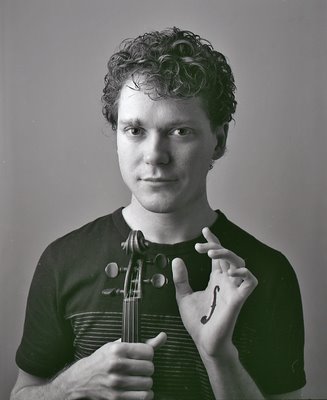
In Saturday's fine Eugene Onegin both Tatyana's mother and nurse say:
Habit is sent to us from above in place of happiness.
I would agree with that stament yet I can see some exceptions. Here is one.
I knew I was going to be taking Corey Cerovsek's photograph today as a very pleasant routine or habit that started in 1987. I am fascinated by taking pictures of people, over and over as one can see time at work. In the case of Cerovsek you can see the boy become a man.

The Onegin quote on habit made me think of Malcolm Parry who once (around 1987) disgustedly told me, "Alex, you are not taking good pictures anymore. You are just making the motion." I was extremely angry and insulted even though Parry may have been right. I have never forgotten his disdain and I have always tried to do my best photographically and to somehow not lose my passion for it. I don't habitually smell my roses every spring. To me in spite of the memory of their scent in my head the experience is a first-time-again one.

Since 1987 I have photographed violinist Corey Cerovsek 6 times. The first time and the second time where in that first year. The folks at Saturday Night wanted me to capture the "devil behind his genius". This I did in my old studio in Yaletown. The second shot was in the back yard of a friend and sponsor of Cerovsek. The bicycle was there (not his) and the T-shirt was mine. I wanted to convey for Vancouver Magazine the fact that the 14-year-old Cerovsek was really, first, a boy.
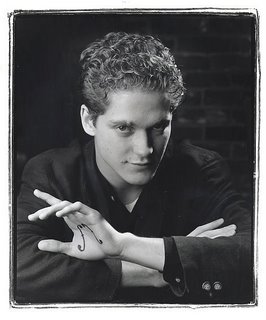
The third very elegant shot I took in a Yaletown beer parlour. As we left I remember Cerovsek saying, "I wonder what would have happened if I had forgotten my violin case that was under the table on the floor. After all it is a ....million dollar Strad." In other years it became fun to find some way of making the picture slightly different for laughs. In 2006 I used a ring flash and a wideangle lens. There was a slight problem with that series as Corovsek's fianceé in Paris (both live in Paris) thought the raised hand looked to much like a Hitler-Jugend salute.

This year, this morning to be accurate, I decided to incorporate just a bit of that ...million dollar Strad. There are no other tricks, no wide angles or weird lighting. Here you see Corey Cerovsek at age 36.
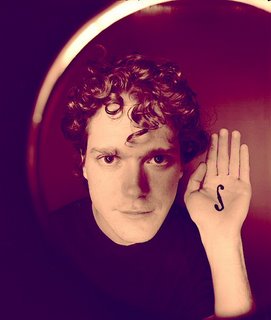
Tonight Rebecca's mother Hilary (Rebecca is not allowed to go anywhere cultural during the week, or much of the rest of it) and I will be listening to Cerovsek play the 1903 Violin Concerto in D minor, opus 47 by Jean Sibelius. After the concert, at the Orpheum with the Vancouver Symphony Orchestra, we will go back stage for a visit.

Habit does not always preclude happiness!






